

The pan-European magazine for the professional cleaning sector
FEBRUARY/ MARCH 2024
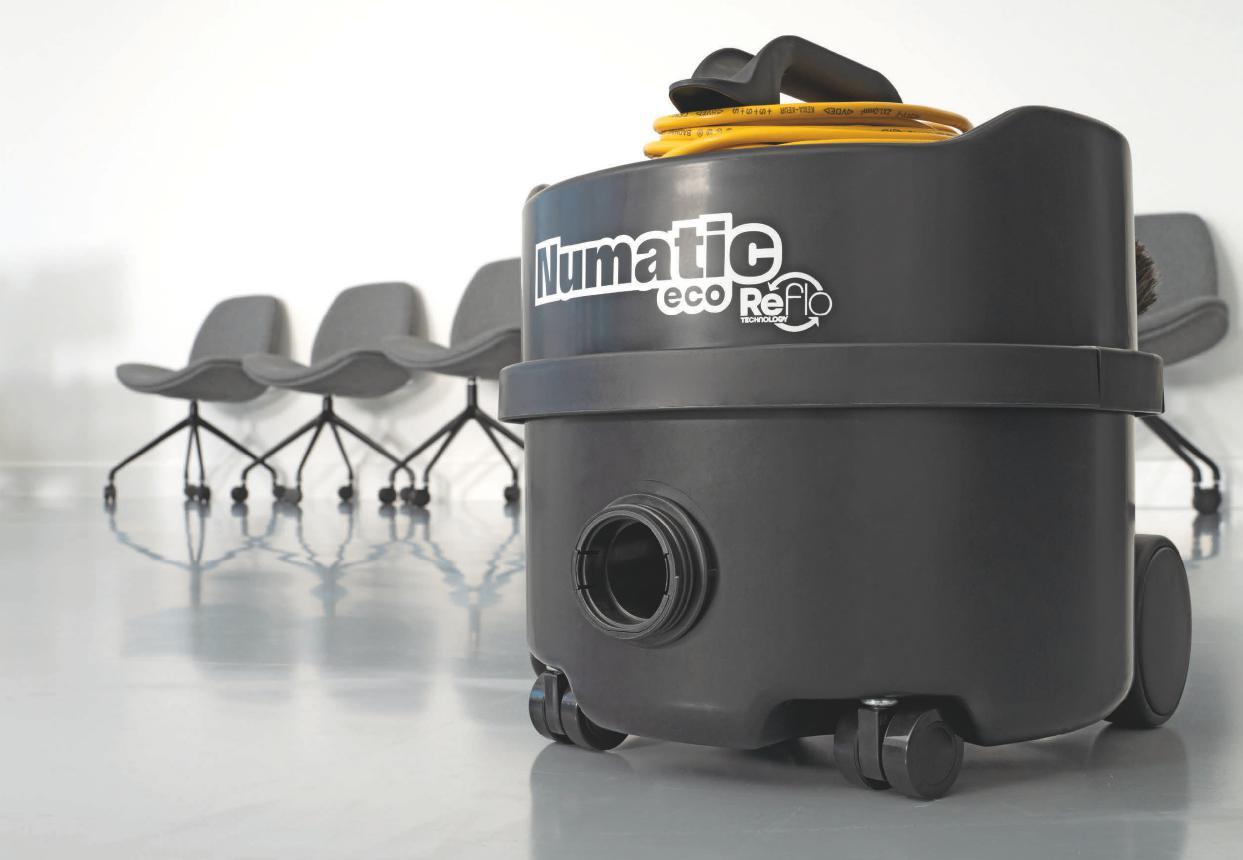

Europe faces a talent challenge

Reducing waste production
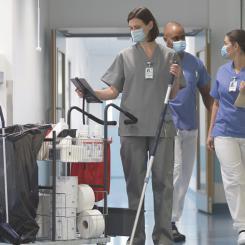
Cleaning staff on the frontline Page
The 2024 European Cleaning & Hygiene Awards are now open for entries
Page 3
Page 39
Page 21
36
BUSINESS SUSTAINABILITY HEALTHCARE

39
Hartley

03
12
14

Criterion
Castle
T
F
Editor
Features
Advertisement
Chris
Advertisement
Laura
Circulation

28
Nilfisk
32
36
41
Hako
46
Corte
T
CONTENTS BUSINESS SPECIAL REPORTS
Europe tackles talent challenges
News
Waste not, want not Manufacturers are limiting the amount of waste they produce.
2024 | Vol.32, No.1
21
February/March
Milner on how Europe needs to up its game in order to attract new talent.
Publishing Ltd
House, 89 High Street Berkhamsted HP4 2DF, UK
+44 (0)1494 791222
+44 (0)1494 792223 info@europeancleaningjournal.com www. europeancleaningjournal.com
UK - £60 / Continental Europe - £70 / International - £80 European Cleaning Journal is published six times a year by Criterion Publishing Ltd. Although every effort is made to ensure the accuracy and reliability of material published in European Cleaning, Criterion Publishing Ltd and its agents can accept no responsibility for the veracity of claims made by contributors, manufacturers or advertisers. Copyright for all material published in European Cleaning remains with Criterion Publishing Ltd and its agents.
Subscriptions
Michelle Marshall
Writer Ann Laffeaty
director
Godman
sales executive
Bell
Marie Payne
Spain & Switzerland Fabio Potesta Mediapoint & Communications
Italy,
Lambruschini, Corso Buenos Aires, 8 V0 Piano, Interno 7 16129 Genova, Italy
+39 010 570 4948
+39 010 553 0088 info@mediapointsrl.it www. mediapointsrl.it ISSN 0968-901X ©Criterion Publishing 2024
F
says climate change brings opportunity to change the sector’s impact.
Opportunity to transform
Washroom strategy
how washrooms must
sustainability
are the main challenges facing healthcare cleaning personnel today?
Satino by WEPA on
be part of the
picture. What
On the front line
Equipped for the future
heads up the special report on scrubber dryers.
CBP007012
European reports
Avoiding the queues
look at how to best equip busy washrooms in stadiums and exhibition halls.
A
Interclean Amsterdam news


THE WORLD’S MOST ADVANCED CLEANING AND HYGIENE SHOW intercleanshow.com/amsterdam 14 – 17 MAY 2024 AMSTERDAM, THE NETHERLANDS Organised by: Official media partner:
European Cleaning & Hygiene Awards back for 2024 - time to enter!
ECJ’s European Cleaning & Hygiene Awards are back for 2024, with entries now open.
Now in their seventh year, the only pan-European awards for the professional cleaning sector give service providers, manufacturers and distributors the opportunity to share their success stories and celebrate the vital work of the industry.
There are 10 categories that encompass themes including sustainability, diversity, partnership, smart solutions and leadership. Here’s the list:
• Start-up Business of the Year
• Best Use of Smart Solutions by a Service Provider
• Investment in Training
• Excellence in Client/Contractor Partnerships
• Sustainability - Best Practice
• Commitment to Diversity in the Workforce
• Best Initiative Raising the Profile of the Cleaning Sector
• Technological Innovation of the Year
• Leader of the Year
• Rising Star
You have until the end of April to submit your entry, with finalists being announced in July. And the ceremony moves to a
different European city once again, with this year’s winners to be announced during the awards ceremony and gala dinner in Lisbon, Portugal on October 3.
Michelle Marshall, editor of European Cleaning Journal and founder of the awards, launched this year’s programme.
“The European Cleaning & Hygiene Awards are gathering momentum every year. Last year was a record-breaker for entries and the awards dinner in Dublin was a tremendous success.
Inspiring stories
“So we are hoping for even more companies and individuals to get involved in 2024. It’s always such a privilege to read such inspiring stories from around the countries of Europe.”
Headline sponsor for this year is Lucart Professional.
You can find the entry form at: www.echawards.com/enter
There you will also find all the information you need about categories and criteria. All entries are to be submited online via the website.
You can also follow the awards on X (formerly Twitter) @ ECH_Awards and #ECHA24 and via European Cleaning Journal’s LinkedIn page.
www.echawards.com
WEPA Professional makes UK buy
WEPA Professional, washroom hygiene products specialist headquartered in Germany, has acquired UK hygiene paper provider Star Tissue UKwhich now operates as WEPA Professional UK.
Andreas Krengel, CEO business unit professional of the WEPA Group said: “WEPA stands for the production of high quality tissue paper, and the UK market is strategically important for us.” The UK business will remain
under the leadership of Khalid Saifullah, who stays on as managing director. He added: “In WEPA Professional we have found a partner that shares our values and stands for high quality products and first-class customer service.”
Thanks to this move, WEPA says, customers benefit from an expansion of the product portfolio and an international production network across 13 European locations.
• Les Prix européens de propreté et d’hygiène tenus sous les auspices de l’ECJ reverront le jour en cette année 2024, les inscriptions pouvant désormais se faire sur le site ECJ.
• WEPA Professional, un spécialiste allemand des produits d’hygiène pour toilettes collectives, a repris la société britannique de papiers hygiéniques Star Tissue UK.

EVENTS
March 13-14 2024
Manchester Cleaning Show Manchester, UK cleaningshow.co.uk/manchester
March 26-29 2024
China Clean Expo Shanghai, China www.chinacleanexpo.com
May 14-17 2024
Interclean Amserdam Amsterdam, Netherlands www.intercleanshow.com
October 3 2024
EuropeanCleaning&HygieneAwards Lisbon, Portugal www.echawards.com
November 18-21 2024
ISSA North America Las Vegas, USA www.issa.com
December 11-13 2024
Interclean China Shanghai, China www.intercleanshow.com/china
March 18-20 2025
The Cleaning Show London, UK cleaningshow.co.uk
May 27-29 2025 ISSA Pulire Milan, Italy www.issapulire.com
September 23-26 2025
CMS Berlin Berlin, Germany www.cms-berlin.de
November 10-13 2025
ISSA North America Chicago, USA www.issa.com
October 19-22 2026
ISSA North America Las Vegas, USA www.issa.com
To have your event included in the Events section, contact ECJ via email at: michelle@europeancleaningjournal.com
• Die ECJ European Cleaning & Hygiene Awards 2024 wurden angekündigt, und Nominierungen können jetzt über die Website vorgenommen werden.
• WEPA Professional, der deutsche Spezialist für Hygieneprodukte für Waschräume, hat den britischen Hygienepapieranbieter Star Tissue UK übernommen.
• I premi di ECJ European Cleaning & Hygiene Awards ritornano per il 2024, con le iscrizioni ora aperte sul sito web.
• La WEPA Professional, specialista tedesca in prodotti per l’igiene delle sale da toilette, ha acquisito la fornitrice di carta igienica nel Regno Unito Star Tissue UK.
NEWS & EVENTS February/March 2024 | ECJ | 3 Latest News & Events from ECJ
Interclean Amsterdam - online registration open
Online registration is now open for Interclean Amsterdam 2024, Europe’s largest event for the professional cleaning sector.
Taking place from May 14-17 at RAI Amsterdam, Interclean this year will feature over 900 exhibitors across 11 halls.
More than 30,000 cleaning professionals from 120 countries are expected to visit.
“Our team has been working non-stop behind the scenes to organise a truly world class and completely unique event,” says Robert Stelling, director Interclean global events.
“We’ve worked hard to bring our visitors exclusive content
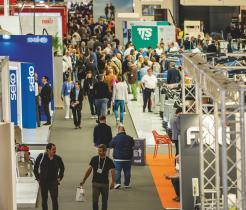
about the world’s most cuttingedge technologies, trends and solutions - all geared towards helping you to discover the best products, services and connections to achieve your business goals.”
The key themes of the show this year are:
• L’industrie européenne de la propreté attend avec intérêt l’ouverture prochaine de l’Interclean Amsterdam, qui se tiendra du 14 au 17 mai au palais des expositions RAI d’Amsterdam.
• Le programme britannique d’apprentissage de niveau 2 des opérateurs de propreté et d’hygiène a été officiellement lancé le 1er janvier.
• Technology/Innovation/ Digitalisation
• Sustainability/Environment/ ESG goals
• Healthcare/Hygiene/ Disinfection
And for the first time in 2024 there are some new opportunities to enjoy the atmosphere of the event. The organisers are promising live music, celebrity line-ups, DJ’s, comedians and other entertainment to enhance the visitor experience.
Visit: www.intercleanshow. com/amsterdam/register
•ECJ is official media partner of Interclean Amsterdam
• Die professionelle Reinigungsindustrie in Europa blickt voraus auf die Interclean Amsterdam, die vom 14. bis 17. Mai im RAI Amsterdam stattfindet.
• Am 1. Januar wurde in Großbritannien offiziell die Stufe 2 der Ausbildung zur Reinigungs- und Hygienefachkraft vorgestellt.
Apprenticeship
January 1 saw the launch of the UK Level 2 Cleaning Hygiene
Operative Apprenticeship - and an appeal has been made to firms to take advantage of rules on gifting funds to allow more apprentices to be supported.
Cleaning Hygiene
Operative Apprenticeships offer the opportunity for sector organisations to use Apprenticeship Levy payments to invest in their staff.
The British Cleaning Council (BCC) is calling on larger businesses to gift or transfer unused Levy funds to smaller businesses.
britishcleaningcouncil.org
• L’industria delle pulizia professionali in Europa sta aspettando la Interclean Amsterdam che si terrà alla RAI Amsterdam dal 14 al 17 maggio.
• Nel Regno Unito, il 1º gennaio ha visto il lancio ufficiale dell’apprendistato Level 2 Cleaning Hygiene Operative Apprenticeship.




NEWS
4 | February/March 2024 | ECJ

‘Chlorine disinfectant does not kill superbug’
One of the primary chlorine disinfectants currently being used to clean hospital scrubs and surfaces does not kill off the most common cause of antibiotic-associated sickness in healthcare settings globally, according to a new study.
Research by the University of Plymouth has showed spores of C. diff are completely unaffected despite being treated with the high concentrations of bleach used in many hospitals. In fact, the chlorine chemicals are no more effective at damaging the spores when used as a surface disinfectant than using water with no additives.
Writing in the journal
Microbiology, the study’s authors say susceptible people working and being treated in clinical settings might be unknowingly placed at risk of contracting the superbug.
Urgent research needed
As a result, and with incidence of biocide overuse only serving to fuel rises in antimicrobial resistance (AMR) worldwide, they have called for urgent research to find alternative strategies to disinfect C. diff spores in order to break the chain of transmission in clinical environments.
Dr Tina Joshi, associate professor in molecular
•Un des principaux désinfectants au chlore utilisés pour le nettoyage de surfaces en milieu hospitalier n’élimine pas la cause la plus fréquente de maladies liées à l’usage d’antibiotiques dans ce milieu, indique une nouvelle étude.
• Les cabines de douche et les tapis d’exercice sont les zones les plus chargées de microbes d’un gymnase, indique une étude récente menée au Canada.
microbiology in the Peninsula Dental School, carried out the study with Humaira Ahmed, a fourth year medicine student from the Peninsula Medical School.
The authors say it highlights the ability of C. diff spores to tolerate disinfection at in-use and recommended active chlorine concentrations. It argues we need disinfectants and guidelines that are fit for purpose and work in line with bacterial evolution, and the research should have significant impact on current disinfection protocols in the medical field globally.
• Eines der gängigsten Chlordesinfektionsmittel, das zur Reinigung von Oberflächen in Krankenhäusern verwendet wird, tötet die häufigste Ursache von Antibiotikaassoziierten Krankheiten im Gesundheitswesen nicht ab, sagt eine neue Studie.
• Duschanlagen und Trainingsmatten sind laut einer neuen, in Kanada ausgeführten Studie die keimreichsten Bereiche des Fitnessstudios.
Germy gyms
Shower blocks and exercise mats are the germiest areas of the gym, according to a study carried out by Canadian consumer programme Marketplace. It checked elliptical equipment, barbells, dumbbells, exercise mats and yoga balls.
The study revealed mats harboured almost eight times as much bacteria as yoga balls and more than dumbells and barbells. Those tested also had high levels of staphylococcus. But the gym showers were of most concern as they harboured more than four times the amount of bacteria as the mats as well as elevated levels of yeast, mould and staph.
• Uno dei principali disinfettanti al cloro utilizzato per pulire le superfici negli ospedali non elimina la causa più comune di malattia associata agli antibiotici nelle strutture sanitarie, così emerge da un nuovo studio.
• A quanto emerge da un nuovo studio effettuato in Canada, l’area delle docce e i materassini per gli esercizi sono le zone con più germi di tutte le palestre.





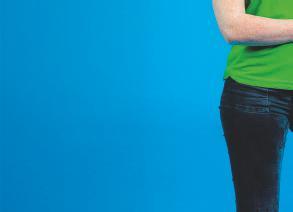

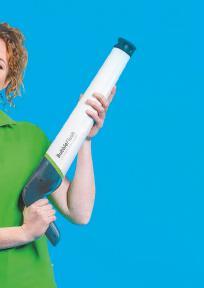
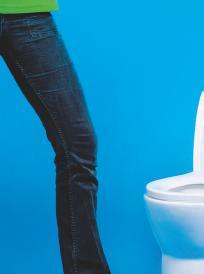






NEWS
6 | February/March 2024 | ECJ



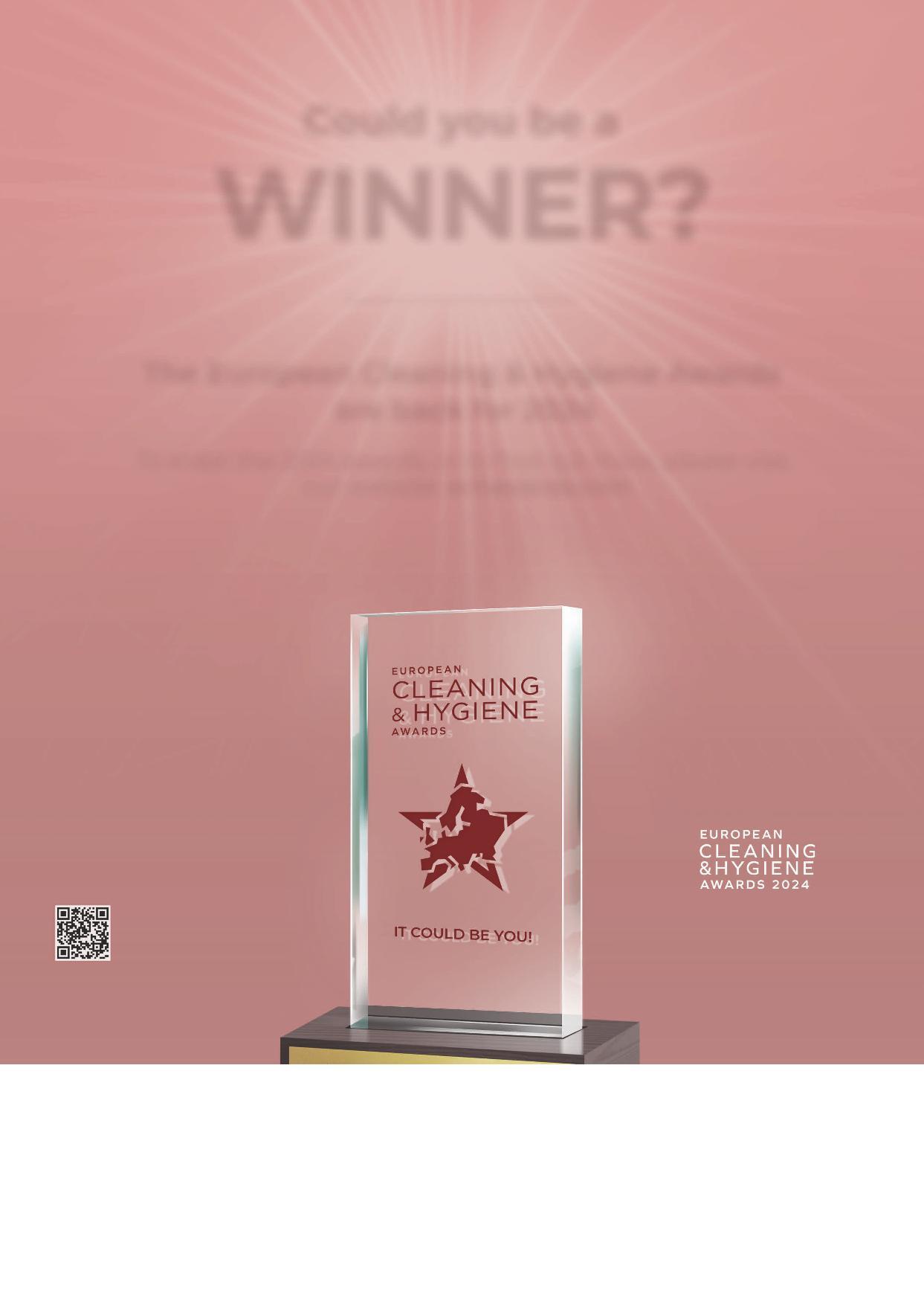
Or scan here WINNER? Could you be a To enter the 2024 awards, or to find out more, please visit our website: echawards.com The European Cleaning & Hygiene Awards are back for 2024 An Essi y brand Sponsors Headline sponsor Media Partners Brought to you by

A fifth of all employees shun the workplace washroom: study
Nearly one in five employees refuse to use the toilets at work because of poor hygiene, a study has revealed.
Low levels of cleanliness coupled with a lack of sanitary supplies such as toilet paper and hand towels prompt many workers to go elsewhere to find a toilet - or wait until they get home.
And 22 per cent of people questioned said they avoided the kitchens at work because of issues such as splattered food and mountains of dirty dishes, according to the study.
‘Breeding ground’
The poll of 2,000 workers, commissioned by global hygiene and health company Essity, found that 45 per cent believe their workplace is a “breeding ground for bacteria”.
Microwaves are the top office hygiene gripe followed by filthy fridges, overflowing bins, dirty sinks, and mouldy food in the fridge.
“During the Covid era it felt as though everyone took their personal hygiene and other people’s safety far more seriously,” said Essity communications director Gareth Lucy. “But oh, how quickly things change. This survey demonstrates a serious drop in office cleanliness at a time when it should still be a number one priority. And employees are understandably frustrated at the conditions in which they are expected to work.”
Around 60 per cent of those polled said they felt
Selon une étude à ce sujet, près d’un salarié sur cinq rechigne à utiliser les toilettes de son entreprise en raison de leur manque d’hygiène.
Fast jeder fünfte Mitarbeiter weigert sich, die Toiletten am Arbeitsplatz aufgrund mangelnder Hygiene zu benutzen, wie eine Studie ergab.
Uno studio ha rivelato che quasi un dipendente su cinque si rifiuta di utilizzare i bagni sul luogo di lavoro a causa della cattiva igiene.
more productive in a clean workspace - and 22 per cent claimed to have complained to management or HR about the state of their surroundings.
However, the study found that some good habits persisted post-Covid with 36 per cent of workers claiming to sanitise their hands regularly while 35 per cent now habitually made solo drinks instead of brewing up for everyone.

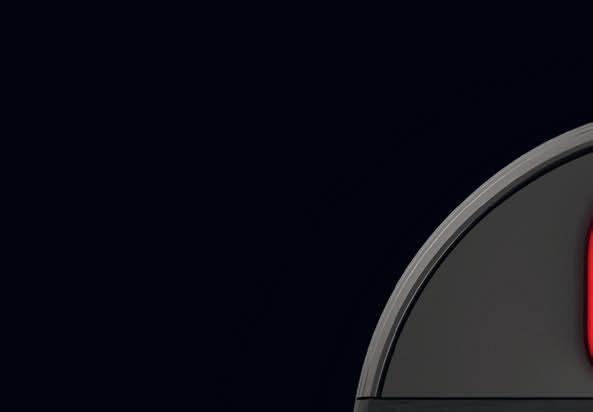











NEWS
February/March 2024 | ECJ | 9




Solutions for professional cleaning Download the catalogue COMAC S.p.A. Via Maestri del Lavoro, 13 - 37059 Santa Maria di Zevio - Verona - ITALY Tel. 045 8774222 - www.comac.it - com@comac.it Comac S.p.A. org. cert. ISO 9001:2015, ISO 14001:2015, ISO 45001:2018, SA 8000:2014
Shaping the future - EFCI’s vision for a dynamic, inclusive industry

EFCI’s strategic program for 2024 focuses on highlighting the crucial contribution of the cleaning sector. The initiative aims to increase visibility not only among governmental bodies but also within the wider industry. Director general Matteo Matarazzo in Brussels tells us more.
On March 6 in Brussels, EFCI will host a significant event. This gathering will serve as the platform for presenting concrete proposals laid out in a manifesto, strategically timed before the European elections in June 2024. The manifesto is crafted to inform policymakers about the unique challenges faced by the cleaning and facility management industry.
More importantly, it provides practical solutions to ensure the industry contributes to the European economic growth and social progress. Topics, such as revising current

public procurement rules and integrating cleaning and sanitation into future EU public health policies, will be explored. The event will be a meeting point for representatives from EFCI’s member associations, industry stakeholders, MEPs and other institutional actors to engage in meaningful discussions.
Wider audience
Later in the year - in May - EFCI will have a presence at Interclean Amsterdam, a leading exhibition in the cleaning sector. This event, along with others such as CMS in Berlin and Europropre in Paris, serves as a crucial space for industry leaders to explore new trends, technological innovations
Le programme de l’EFCI pour 2024 vise en premier lieu à sensibiliser à la contribution cruciale du secteur de la propreté. Il entend sensibiliser non seulement les instances publiques, mais également l’industrie entière.
and policy issues shaping the sector’s development. Last but not least EFCI will unveil its manifesto to a broader, industryfocused audience.
Towards the end of 2024, EFCI, in collaboration with ANIPConfindustria, Confindustria HCFS, and the LIFE Foundation, will host the 2024 edition of the LIFE event in Brussels. A summit of the Italian labour-intensive industry, LIFE has historically been a forum for high-level exchange and debate on critical issues facing the cleaning, contract catering and related industries. This year’s edition, with a true European dimension, emphasises the substantial impact of a sector employing over four million workers on the
Das strategische Programm des EFCI für 2024 konzentriert sich darauf, den entscheidenden Beitrag der Reinigungsbranche hervorzuheben. Die Initiative zielt darauf ab, die Sichtbarkeit nicht nur bei den staatlichen Stellen, sondern auch in der Industrie im weiteren Sinne zu erhöhen.
continent’s economy, with farreaching societal implications and a significant influence on collective wellbeing.
New EU cycle
Beyond these main events, EFCI’s 2024 agenda remains active, aligning with the lead-up to the new EU political cycle. As the new European Commission takes shape and the European Parliament undergoes renewal, EFCI promises to keep stakeholders informed through various communication channels. This proactive approach ensures the industry at large can actively participate in EFCI’s initiatives, contributing to shared success.
In conclusion, EFCI’s visionary programme for 2024 reflects a commitment to fostering a dynamic, inclusive and forwardlooking cleaning industry. As the association representing cleaning and hygiene at the European level, the sector’s role extends far beyond its surface, influencing economic growth, societal wellbeing, and the broader European landscape. EFCI invites all stakeholders to join hands in this transformative journey as we collectively shape a cleaner and brighter future for Europe.
www.efci.eu
Il programma strategico della EFCI per il 2024 mette in evidenza il contributo cruciale del settore delle pulizie professionali. L’iniziativa mira ad aumentare la visibilità non solo fra gli enti del governo ma anche nell’ambito dell’industria in generale.
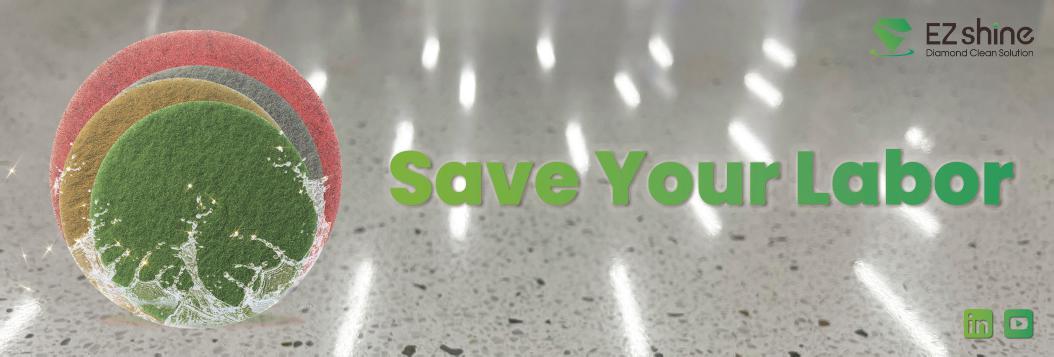
EFCI NEWS
February/March 2024 | ECJ | 11
Looking forward to Europe’s biggest cleaning industry show

Europe’s largest exhibition for the professional cleaning sector - Interclean Amsterdam - will take place from May 14-17 at RAI Amsterdam. Robert Stelling, director of Interclean global events at RAI Amsterdam, tells us more about what to expect in this exclusive piece for ECJ. ECJ is the official media partner of Interclean Amsterdam.
This year Interclean is pulling out all the stops. Our team has been busy working to organise a truly world class and unique event. It promises to be informative, inspirational and entertaining. We’ve worked hard to bring our visitors exclusive content about the world’s most cuttingedge technologies, trends and solutions - all geared towards helping visitors to discover the best products, services and connections.
With 11 halls featuring more than 900 exhibitors showcasing their latest products, services and knowledge, it’s set to be a groundbreaking edition. The line-up promises to be bigger, better and bolder than ever. In-person meeting is vital for networking and showcasing innovations and - with exhibitors from across the globe, representing every sector of the industry - we’re able to provide the full overview of the latest advances and developments in professional cleaning and hygiene under one roof.
More than a trade show Interclean provides you with the latest news, views and analysis on cleaning and hygiene. Showcasing the products, services and
En

innovations from the world’s leading industry experts and companies, it’s renowned worldwide for being the most trusted and respected international business networking platform for the cleaning and hygiene industry. Interclean Amsterdam has gone from strength to strength since it was first founded in 1967.
What makes this year’s edition different is that we’re really focusing on the future of the industry: what changes are coming and how will they impact your business? This is your exclusive opportunity to meet the right people and make the right connections, as you discover what innovations can help you evolve and grow your business. It’s also the perfect place to find out how the industry (and you) can make an impact with sustainable solutions that protect both people and the planet.
Networking and leisure
But it’s not all work and no play! Interclean Amsterdam 2024 offers an immersive experience, with not only ample chances to network and testdrive the latest innovations - but also the opportunity to have a great time. We’ll be introducing
Im
a special keynote speaker as the kick-off to the event, talking about transformation for the industry. And this year for the first time there will be a daily Interclean Social Club at three show-floor locations featuring live music, stand-up comedy, a pub quiz and more surprises at the event. Without giving too much away, we will also be unveiling a whole new look. Join in discussion
What can visitors expect? We are exceptionally proud that Interclean Amsterdam 2024 will unite all the market leaders, role players, industry experts and exhibitors from across the world and from China. Join in discussions about cuttingedge topics such as: the value of data: what does it yield?; privacy and robotisation; energy transformation and real estate; staff, training and integration; cleaning and hygiene in the food service industry; greenwashing and certification; indoor air quality; and washroom hygiene. Visitors can also look forward to attending the Healthcare Cleaning Forum (HCF). This conference - developed in cooperation with CleanHospitals - is designed as a platform for healthcare and cleaning experts
In
as well as hospital managers, infection prevention specialists and facility managers. It provides in-depth insights into current trends and challenges affecting healthcare cleaning and hygiene in hospitals and long-term care institutions.
Another highlight is the Amsterdam Innovation Award which is awarded to the most innovative product, service or solution in the cleaning and hygiene industry in four categories - before the overall winner is announced.
This year we’ll be introducing a new category: the Cleaner’s Choice Award, where the finalists of the Dutch Cleaner of the Year competition will vote for the most impactful innovation that will help them the most in their work. All winners will be announced during the opening ceremony.
Uniting community
What makes Interclean Amsterdam so special is that our visitors and exhibitors come to do business with the world! At this independent platform you really gain a global overview, where everyone is welcome and all voices are heard. Our focus has always been on innovation, impact and the future of the industry. It’s not about the products, it’s about the impact and the people.
As we navigate through the exciting innovations and trends that are shaping the professional cleaning and hygiene community in 2024, Interclean will continue to deliver solutions for a cleaner, healthier and more sustainable world. Whether you are a cleaning professional, facility manager, or simply interested in staying informed about the latest advancements, Interclean Amsterdam will continue to offer you valuable insights into the future of our industry.
• For details of how to register visit: intercleanshow.com/ amsterdam/register
NEWS: INTERCLEAN AMSTERDAM
prévision de l’Interclean Amsterdam en mai, Robert Stelling, directeur des manifestations Interclean mondiales au RAI Ambsterdam, nous donne un aperçu de ce qu’il faut prévoir à ce salon.
Vorfeld der Interclean Amsterdam im Mai gewährt uns Robert Stelling, Direktor von Interclean Global Events bei RAI Amsterdam, einen Einblick darauf, was uns bei der Ausstellung erwartet.
vista della Interclean Amsterdam che si terrà a maggio, Robert Stelling, direttore degli eventi globali di Interclean alla RAI Amsterdam, ci fa un’anteprima su cosa aspettarsi all’evento.
12 | February/March 2024 | ECJ
• Robert Stelling, director of Interclean global events at RAI Amsterdam
The digital revolution of laundry hygiene




WORLD PREMIERE
Interclean Amsterdam 2024
Hagleitner Innovation World 730 (stand 05.312)
Hagleitner main booth (stand 05.213)
Discover even more new products.
























Schedule your Interclean appointment with Hagleitner now
www.hagleitner.com
Innovative
Hygiene.
-
LATEST: UK
How to make sense of ESG goals?
How can the cleaning sector unravel the ESG goals set by the UN? Lynn Webster takes a closer look.
The New Year started with impacts from COP26 for many organisations. Topics covering youth and public empowerment; nature and land use; transport the built environment; energy, science and innovation.
Unravelling of ESG goals for any cleaning company has its challenges and this is compounded for the smaller and medium size companies which do not have the resources to employ specialists.
When clients require a series of responses covering Scope reduction targets both for client sites and in overall business terms; improving ‘sustainability’, sustainability-focused interventions; business life cycle assessments along with using governmental GHG conversion tables for carbon emissions.
As a very generalist overview it could be said that sustainability is the broad holistic outlook encompassing many environmental (impact on the planet, our world’s natural resources), social (human rights; equity; impact on our people, staff, clients and the community) and economic (our business finance; prosperity, clear decision making & responsibility) areas. Then in turn ESG becomes the structured framework to assess all of those functions - the collective business impact on the environment and on society with robust and transparent governance.
In the UK recently the Cleaning & Support Services Association (CSSA) held a workshop as part of its key objective to identify and raise ESG activities.
This included feedback on research on members’ websites, promotion and illustration of their ESG message covering management information; reporting policy statements; accreditations; Scope 1,2 & 3
Comprendre le sens des critères environnementaux, sociaux et de gouvernance (ESG) n’est pas facile pour une entreprise de propreté. Rapportant du RoyaumeUni, Lynn Webster se penche sur la question.
carbon reduction; social commitments; fair pay; charitable activities training and wellbeing
Some valuable insights were provided looking at leadership, culture and what clients are now expecting. Some website and company profile literature could be described as anything from ‘“acronym soup” to a plethora of ‘greenwashing’ statements so there was certainly learning to share and debate to be had.
Recommendations include
• Make statements that are relevant and make sense
• Describe real actions with concrete evidence
• Core principles with fundamental messages of what you do whilst being comfortable with what you know
• Consider ESG from all angles inclusively
• Don’t make pledges without the ‘how to’ being explained
• Question if social aspects are fully communicated to all stakeholders with clear evidenceinfographics could tell the story much better than text.
Then overall define what peg to hang your business on with understanding of what is relevant and matters to you. Many companies are doing some really great activities but not reporting them.
Taking this feedback alongside some general outcomes from COP26 this can focus on:
• The growing trends for more purposeful business practices
• Increased reporting of positive initiatives with detail and supported data;
• Review of ill-defined words and irrelevant statements
• Take a new look at the value of employment where the next generation will want wellbeing, personal development, diversity, civic responsibility as prized values.
Die Ziele der Umwelt-, Sozial- und Unternehmenssteuerung zu verstehen, stellt für jedes Reinigungsunternehmen eine große Herausforderung dar – Lynn Webster in Großbritannien beleuchtet die wichtigsten Probleme.
LATEST: DENMARK
High-fives, hearts and cake
Dare un senso agli obiettivi ESG è molto impegnativo per qualsiasi impresa di pulizia. La corrispondente del Regno Unito Lynn Webster fa un pò di chiarezza sulle questioni fondamentali.
The first Cleaners’ Day in Denmark went well with the sector, says Lotte Printz.
Imagine entering an empty office every night when everyone else has gone home, working on your own without the support of colleagues and without any recognition for your job whatsoever…
That’s what everyday life for many cleaning operatives looks like and that’s how one of numerous posts on social media started on December 4th 2023 when the first ever Cleaners’ Day went ahead in Denmark. Social media was overrun with support and expressions of approval from cleaning companies and other workplaces that employ cleaning operatives. The mayor of Taarnby encouraged municipality staff to give cleaners a pat on the back on passing them in the corridors.
Around the country, cleaners were also met with high-fives, chocolate hearts and cake. And some employers had organised luncheons, bought flowers for their cleaners and produced badges to make this special day more visible.
Cleaners surfaced, so to speak, and their visibility increased - at least for one day. But the whole point of this celebration is, of course, to draw more attention to the valuable work they do - generally. In workplaces and society at large.
“Their work and efforts are absolutely essential to society. The Covid era showed us that cleaning needs prioritising (…) and thankfully it seems as if cleaning is made a ‘visible profession’ wherever possible. To ‘see’ your cleaner and to have a dialogue help strengthen the industry image,” chairperson of DRF (the Danish Association for the Technology of Cleaning and Maintenance), Jytte Hansen, said
Rapportant du Danemark, Lotte Printz évoque la première journée à être consacrée dans ce pays à la célébration des travailleurs de la propreté. Cette journée a été bien reçue par le secteur, mais peu saluée par les médias.
Media still reluctant.
in the cleaning industry magazine ‘Rent i Danmark’ leading up to the event.
The two started the initiative. It was, however, a successful Nordic cleaning industry network that set the whole thing going, and the Danish ‘take’ on Cleaners’ Day was strongly inspired by the other Nordic countries where a similar event has taken place for years. Now, it seems, it’ll be a recurrent event in Denmark, too. Speaking to ECJ after the event, Jytte Hansen stresses:
“One thing is to draw attention to this sector and enhance the industry image. Another is to improve conditions under which cleaners work. Their quality of life and wellbeing. Contributing to their wellbeing will eventually help reduce sick leave.”
“Another important factor is that ‘visible cleaning’ will benefit integration of the many people of foreign origin who work in this industry and who may struggle with the Danish language,” she adds.
While generally considered a success within the industry, Cleaners’ Day did not really hit the headlines on a broader scale. The cleaning industry is rarely covered in mainstream media –unless there’s a scandal involved as Jytte Hansen puts it. Or as it happened at the beginning of 2024 when parents complained about ‘visible cleaning’ in an Odense nursery as it felt insecure for their children to see ‘strangers’ and vacuum cleaners moving around in their vicinity!
However, hopes are still high in the industry that ‘visible cleaning’ will survive the criticism and that mainstream media will eventually spot the positive sides of the business.
Lotte Printz berichtet aus Dänemark über den ersten Tag überhaupt, an dem Reinigungskräfte gefeiert wurden, der zwar von der Industrie gut aufgenommen wurden, aber weniger Beachtung in den MainstreamMedien fand.
Dalla Danimarca, la corrispondente Lotte Printz ci informa sulla prima giornata in assoluto dedicata alla celebrazione degli addetti alle pulizie che è stata ben accolta dall’industria ma meno dai media tradizionali.
14 | February/March 2024 | ECJ
Solutions to combat poverty risk
Low-skilled workers in the Dutch cleaning sector are at a higher risk of poverty, explains VSR’s John Griep.
A 2021 report by the Social Economic Council (SER) shows low-skilled workers in the Dutch cleaning sector are at greater risk of poverty. The issue occurs in all sectors with relatively more minimum wages, temporary workers and short working weeks. All properties that are characteristic of the Dutch cleaning sector. The increased risk of poverty is a difficult issue for which no single factor can be blamed. Various parties contribute to the problem: cleaning companies, customers, but also the risk group (cleaners) themselves. At VSR we offer solutions to reduce the risk of poverty.
The problem is partly caused by cleaning companies. In practice, they are very reluctant to offer contracts which include fixed working hours. Not only because of risk reduction, sometimes those hours are simply not available. The explanation for this is simple: a lot of cleaning work takes place in the evening outside office hours during fixed time slots. Logical from the client’s perspective, but this is a significant limitation for the cleaners. Spreading working hours is often impossible for the client and as a cleaner you can only be in one place at a time.
Cleaners therefore feel forced to work for multiple employers in order to work more hours. They often do not realise this increases the risk of stress and additional tax burden. The extra tax burden in particular leads to problems. Often not enough tax is paid because the payroll tax credit is applied by multiple employers. Legally, an employee may only receive payroll tax credit from one employer in the Netherlands. And that leads to additional taxes from the tax authorities for the employee. A big setback for cleaners who are barely making ends meet.
Dans son compte-rendu des Pays-Bas, John Griep, de l’organisation VSR, parle des solutions à envisager pour réduire la pauvreté dans le secteur de la propreté.
Other factors that increase the risk of poverty lie with the cleaners themselves. They are often poorly educated, face a language barrier and have limited digital knowledge. All obstacles that make it harder for them to negotiate with employers. It also limits communication with government agencies - to apply for support or subsidies. So cleaners are often poorly informed about the income support they are eligible for.
At VSR we started looking for solutions. We mainly advocate preventive measures. This includes providing information to cleaners about budget management and available schemes. Cleaning companies could play an active role in this.
For example, from January 1 2024, the annual government subsidy for employers ‘Tel mee met Taal’ has been available. As an employer, you thus invest in basic skills (language, arithmetic or digital skills) in the workplace.
That being said, it is not the case no initiative is taken at all by cleaning companies. There is just a considerable gap between what large and small employers can do. The major players often have extensive HR support and enough resources to offer support services. At small cleaning companies we see in practice it is difficult to offer the same.
But a significant investment is not always necessary to make a positive contribution as an employer. With extra involvement you can more easily identify problem cases and quickly see what you can do for someone. You can also discuss the distribution of hours with clients. If possible, you can offer contracts with more fixed hours.
Working in the cleaning sector is tough, but honest work. And cleaners should at least be able to make a living from it.
Aus den Niederlanden berichtet John Griep (VSR) über mögliche Lösungen zur Bekämpfung eines höheren Armutsrisikos in der Reinigungsbranche.
Wages and Olympics bring doubt
French cleaning firms face uncertainty in 2024 as wages rise and the Olympic Games take place there.
The year 2023 was an active but quite varied one for French cleaning companies and their clients. The economic background encouraged a high number of takeovers among companies large and small.
According to Patrick Klug, managing director of Entreprises et Décisions, a financial planner based in Paris, “the cleaning market is in quite good shape although it’s obvious that with an 11 per cent rise in wages over two years and the current rate of inflation in France, the cleaning sector is going to suffer.
“However, one should distinguish between the smaller companies - who can more easily pass on their costs to clients confronted with the same problems - and the larger businesses working with public or private clients - whose buyers a far more reluctant to accept substantial price increases.” The current level of acquisitions in the sector is also part of the picture, he said.
In fact, one can expect that level to remain high during 2024. One major such acquisition is the takeover of ISS France by Onet, a major operator on the cleaning market. In addition, there are a couple of quite large cleaning companies who are looking for takeover partners.
A difficult economic context
The strong growth the sector has enjoyed for the past several years could be seriously slowed down, if not stopped, during 2024 owing to a complicated economic situation marked by
a very high rate of wages and cost increases. In the context of its struggle with large public clients to have its price increases accepted, the French cleaning federation (FEP) has launched an official ‘Index propreté’, that is, a cleaning services price index which is to serve as a reference for updating or revising cleaning contracts. The FEP has announced the index will be published every quarter.
This initiative is most important given the weight of public sector clients in the business of cleaning companies. Indeed, these clients represent a quarter of that business and are vital for both large groups and small companies, the latter catering for local authorities.
Will the Summer Olympic Games have an impact?
Specialists are expecting that a great number of contracts will be renewed or extended to include new services during the year. This should involve both private companies and local authorities and include the development of new markets for the sorting out and collection of waste.
The Summer Olympic Games in Paris are also part of the picture. Although it’s difficult to know what their impact will be on cleaning companies in the Paris area, whose employees represent a third of all the professional cleaners in France, one can assume that they’ll have to adapt their organisation and travel arrangements during the whole summer.
Dai Paesi Bassi, John Griep della VSR ci informa sulle soluzioni possibili per combattere un più alto rischio di povertà nel settore del cleaning professionale.
L’année 2024 s’annonce incertaine pour le secteur français de la propreté en raison de fortes hausses salariales et des JO d’été à Paris, affirme Christian Bouzols.
Der Reinigungsbranche in Frankreich steht 2024 wegen der Lohnerhöhungen und der Olympischen Sommerspiele ein unsicheres Jahr bevor, meint Christian Bouzols.
Il 2024 è destinato a essere un anno incerto per il settore delle pulizie in Francia, come ci riferisce il corrispondente Christian Bouzols, a causa dell’aumento dei salari e delle Olimpiadi che si terranno in estate.
LATEST: FRANCE
LATEST: NETHERLANDS
February/March 2024 | ECJ | 15
Hygiene
are now open for entries - www.echawards.com
The 2024 European Cleaning &
Awards
LATEST: GERMANY Young cleaner wins national title
ECJ correspondent in Germany Katja Scholz reports from the latest Craft Skills championship.
The winner of the 72nd German Craft Skills championship in the contract cleaning sector is Sarah Lutz. The 20-year-old from Baden-Württemberg in south Germany was the only female trainee worker along with nine men at the start of the competition, secured the national title in the final. This kind of championship is unique in Europe and has German federal president Frank-Walter Steinmeier as its patron. It is hosted by the German Confederation of Skilled Crafts (ZDH) and the Foundation for the Promotion of Talented Craftsmen which in turn are supported by the Federal Ministry for Business and the Environment (BMWK).
The aim of the competition is to showcase the varied range of skilled trades and to encourage outstanding young talent. It is open to journeymen and women who have passed their examination with a minimum overall grade of ‘good’ and who are no older than 27 at the time of the examination.
From over 130 different skilled trades, the best graduates of the year in their respective trades came forward to compete for the national title. This year there were more than 3,000 young entrants at the start of the competition, which extends over several stages. To start, the top candidates have to compete at guild or trade chamber level in practical tasks and show they can apply what they have learned during training under time pressure.
The next stage is at state level where the winners can apply for a scholarship for further training. For the roughly 900 remaining finalists, the trade associations then organise the national competitions.
The venue for this year’s championship was St Lambert’s
Rapportant d’Allemagne, Katja Scholz présente le gagnant du 72ème championnat d’artisanat du secteur de la propreté de ce pays.
Basilica in Düsseldorf. Participants had to demonstrate their knowledge and skills in three different areas: deep cleaning of church safety glass, deep cleaning of fabric upholstery covers and machine cleaning of natural stone flooring.
“When else does one have the opportunity to be responsible for the cleaning and thus the preservation of a centuries’ old city landmark?” said Matthias Stenzel, Federal Association of Contract Cleaners board member responsible for vocational training. This year’s winner, Sarah Lutz, following her Abitur (school leaving examination) in 2021, completed her dual training with top marks and is currently employed by the Research and Testing Institute for Facility Management.
Her next plan is to take her master craftsman’s examination. Her two cleaning colleagues who took second and third places are respectively Leon Hunte from Lower Saxony and Paul Knieper from Rhineland-Palatinate. The three top competitors will receive the Federal Association of Contract Cleaners’ Carl Gegenbauer prize worth a total of €4,500. And they will compete next year for the €2,000 Newcomer Prize.
Winner Sarah Lutz is proud of her title and has dedicated it to all the other young women working with her in a skilled trade. She would like to see greater promotion of skilled trades, particularly in schools and on social media. “People are always amazed when I tell them that as a 20-year-old journeywoman I am already working in management roles. There is a distinct lack of knowledge about the diversity and career opportunities in skilled trades. It’s time to catch up”, was her message.
Katja Scholz berichtet für das ECJ über die Siegerin bei der 72. Deutschen Meisterschaft im Handwerk in der Sparte Gebäudereinigung.
LATEST: ITALY
When a home becomes a business
From Italy, Anna Garbagna tells us about the growth of cleaning business in short-term rental properties.
Among the many effects of the pandemic, there has certainly been an increase in short rentals, today a sector of great interest. In addition to hosting healthcare professionals during the health emergency, the short rental has guaranteed hygienic safety features as well as confidentiality and it is still doing well. Today more than ever in Italy, where the development of short term rentals shows no signs of abating (+54 per cent in the first six months of 2023 compared to the previous year), regulations are getting stricter, especially where hygiene and cleaning are concerned. So, alongside the clear domestic aspects of this market, a market is developing that we could define commercial, run by companies that are now dedicated to this kind of cleaning.
According to the research presented by Osservatorio Assocasa (National Association Detergents and Specialities for the Industry and for Homes) in cooperation with Nielsen IQ, the sector has recorded a growth of 8.6 per cent in the period ending August 2023. With a total turnover of €4.2 billion it recorded an increase of €333 million compared to the previous year. While price increases certainly had their part in this growth, much is also due to growth and the change in consumer purchasing and hygiene habits.
Abrasives and disinfectants recorded an increase of 15 per cent while cleaning chemicals recorded a growth of five per cent. The increase of these products for domestic cleaning is also partly due to the legislative regulation of sanitisation of surfaces in short rental properties. In addition to thorough cleaning, the regulation now
requires sanitisation or purification of the rooms, using alcohol based chemical agents and/or bleach (70 per cent) designed to kill germs and viruses which, even though they can survive up to nine days on inanimate surfaces, become inactive with the use of disinfectants suitable for hospital use. These are the protocols of the Health Institution (Istituto Superiore di Sanità) and the provisions of the relevant ministry.
Regular washing
It is also vital that all rooms are ventilated to be free from harmful substances and that the cleaners are provided with personal protective equipment such as masks, gloves, overshoes and scrubs.
Curtains, bed sheets and sofa covers must be regularly washed to the maximum temperature accepted by the different types of material or, alternatively, a portable steam cleaner must be used.
In addition, for a correct approach to the guest, it is advisable to make available some dispensers with hydro alcoholic solutions, cotton wipes or disposable wipes, specific cleaning agents for hands and products for cleansing different surfaces. Last but not least, it is vital to provide correct information for guests in order to make them feel safe and protected. And, because there is a lot to do when someone is renting a place for a short period of time, technology can come to the rescue: Chore Checklist, Sweepy, Tody and Nipto are just some of the apps that can help to keep everything under control. Professionalism, the correct products and diligence will take care of the rest.
La corrispondente di ECJ Katja Scholz ci informa sul vincitore della 72a edizione del campionato German Craft Skills nel settore delle pulizie professionali.
Anna Garbagna, notre correspondante en Italie, jette un coup d’œil sur le marché croissant du nettoyage de logements loués à court terme.
Anna Garbagna berichtet aus Italien und wirft einen Blick auf den wachsenden Markt für die professionelle Reinigung von Wohnungen zur Kurzzeitmiete.
Dall’Italia, la corrispondente Anna Garbagna prende in esame il mercato in espansione delle pulizie professionali delle abitazioni affittate per periodi brevi.
16 | February/March 2024 | ECJ
LI-ION: DURABLE AND EFFICIENT
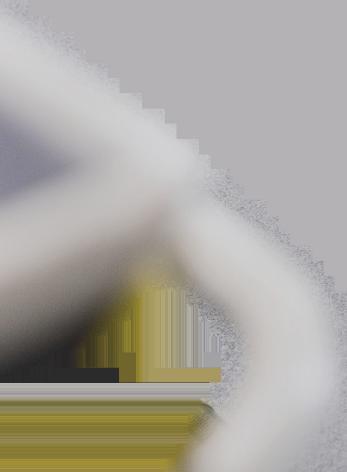
Scrubber dryers must work perfectly in order to be profitable. Lithium-ion batteries ensure a high availability, a low failure rate, and significantly fewer battery changes. This saves time, resources, and money. karcher.com
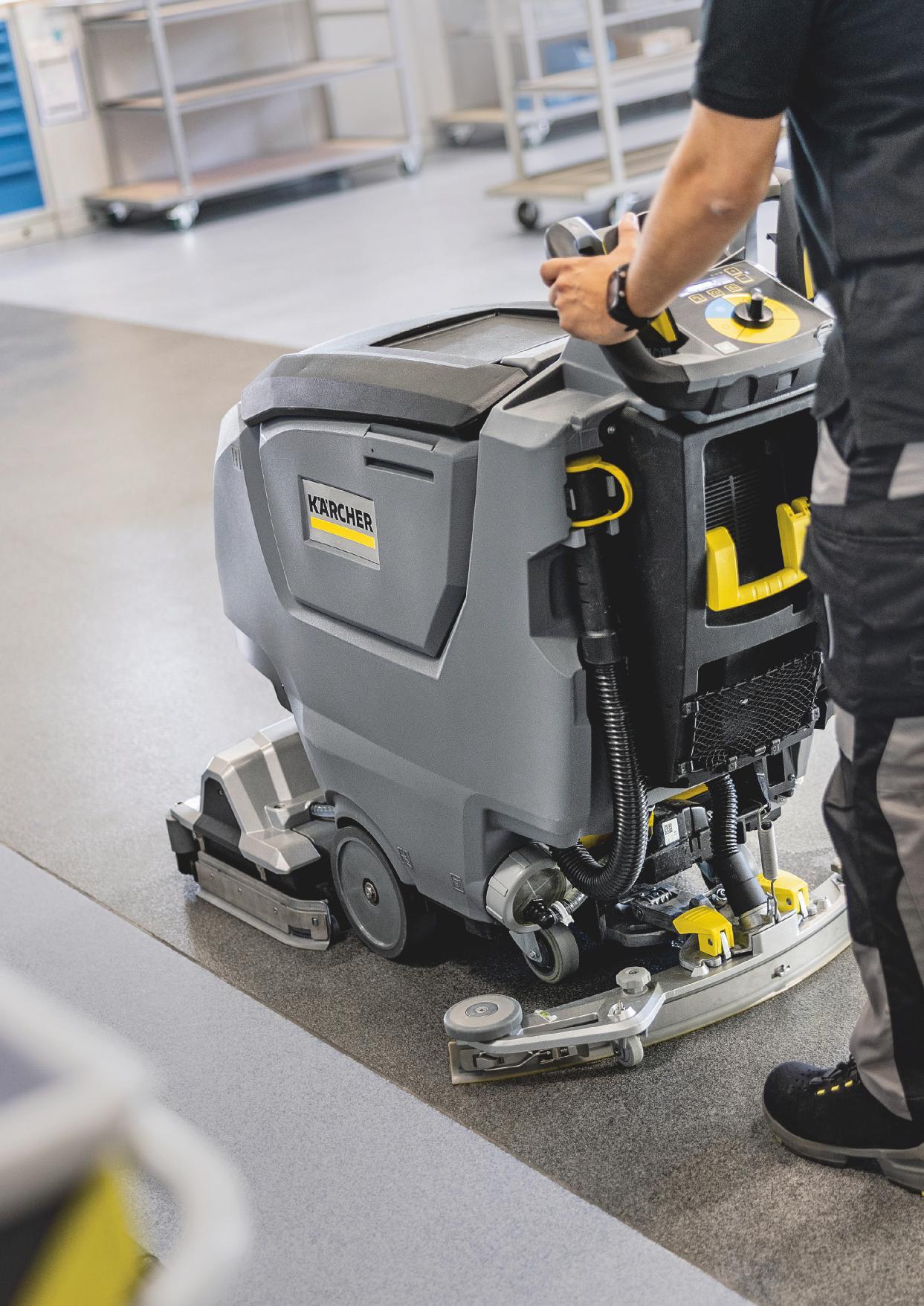

Performance You Can Trust from the UK’s No.1 WORKS HARDER LASTS LONGER BUILT SMARTER WORKS HARDER LASTS LONGER BUILT SMARTER Pro features include a high-efficiency TriTex filter, multi-surface ProFlo floor tool, long 10 metre hi-vis cable, and high-quality Stainless Steel tube set. Built for the long haul with a 2-Year Commercial Warranty and a motor designed and tested beyond industry standard. Made from minimum 45% recycled plastic, including all accessories, using ReFlo Technology. *UK’s No.1 Commercial Vacuum Manufacturer.
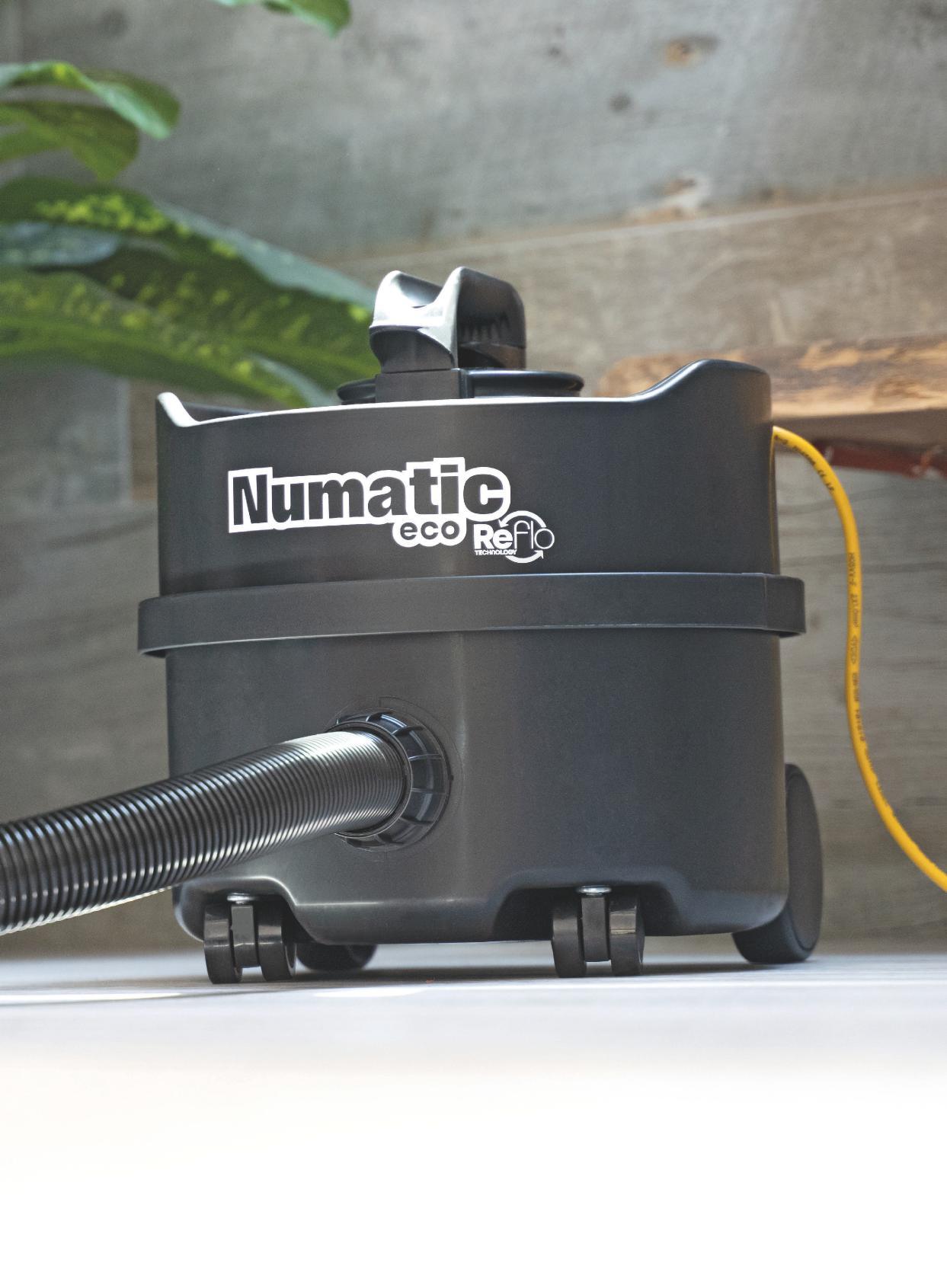

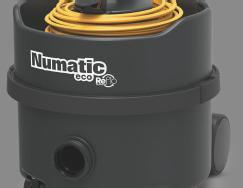



 ERP180
ERP180
Discover our sustainable ReFlo vacuum series at numatic.co.uk ©Numatic International Limited 2024 Made using recycled plastic
PRP180
GET READY FOR MORE FIZZ AT INTERCLEAN AMSTERDAM
14 - 17 May - RAI Amsterdam - Booth 01.106
TINY TABS, MASSIVE IMPACT
Contribute to Waste-free cleaning
Innovation, networking, and fizzy solutions
Meet us at booth 01.106
Register now for free
Hello!
I’m the newest member of the Tab family
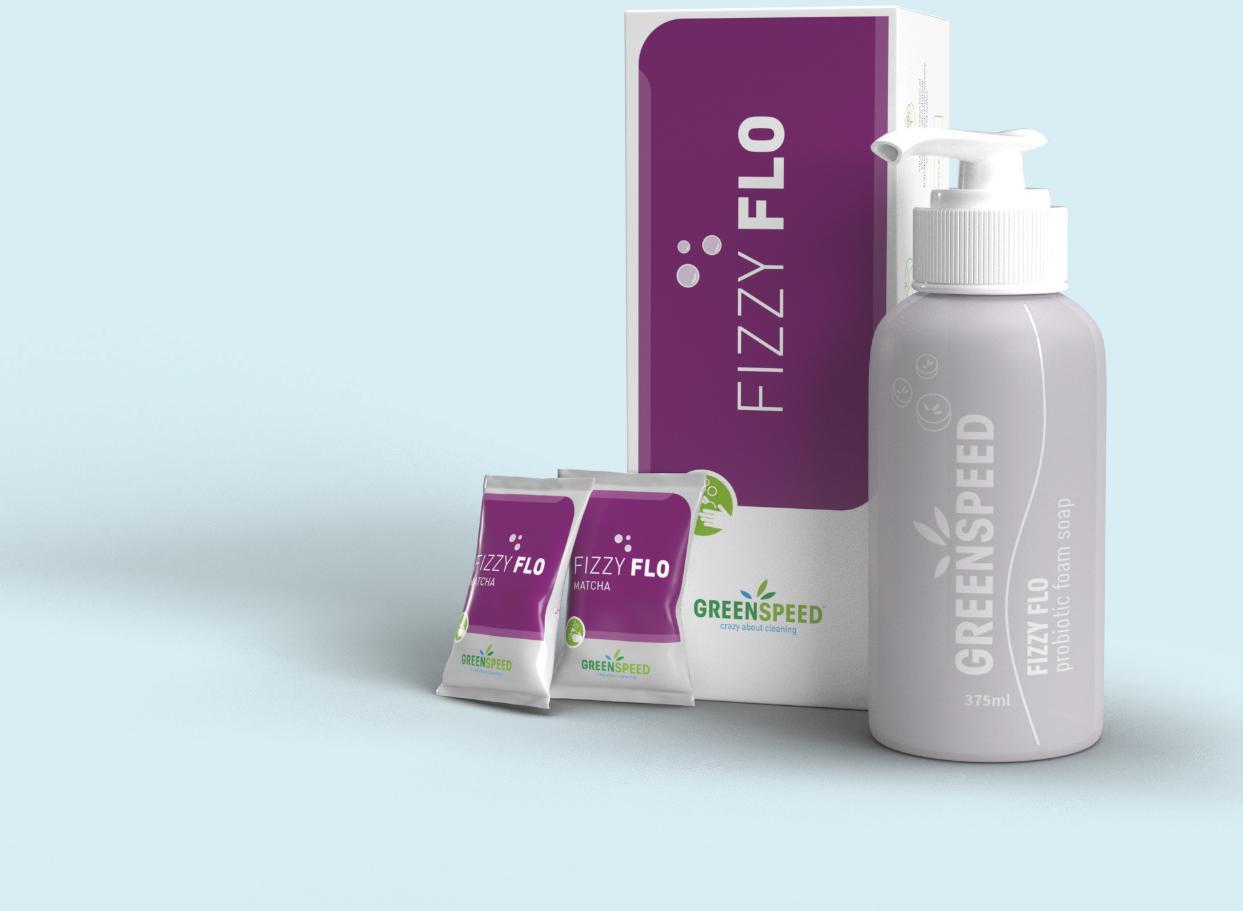
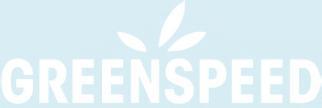
Get your access pas via the QR code!
Waste not, want not

WASTE IS ONE OF THE BIGGEST issues facing industry today. And in a world where we are all striving to re-use and recycle it can be hard to accept that some industry by-products simply need to be thrown away after use.
According to dispenser producer Losdi marketing and communications manager Pau Ortiz, between 7,000 and 10,000 million tonnes of waste are generated around the world each year – most of which comes from production and industrial processes. This means companies need to have a sustainability plan if they are to reduce their environmental impact while also remaining profitable.
“If we continue along our current path it will not only aggravate the problem of climate change, it will also worsen our living conditions due to ocean pollution and poorer air quality,” says Ortiz.
Losdi strives to repurpose all its waste materials, he says. “Any injection-moulded plastic that is defective or unusable is crushed and reallocated for future production processes,” he said. “This reduces the volume of waste from resources to practically zero. And our Eco-Luxe paper and soap dispensers are made from 100 per cent recycled post-consumer plastic.”
Kärcher strives to reduce waste from the outset during product development, says senior director corporate sustainability management Marie Kristin Schmidt. “We use recycled material in place of virgin materials where we can and ensure our products are as durable and repairable as possible, while also avoiding any unnecessary packaging,” she said. “We also consider how to give our products a second life after they have fulfilled their function at the customer’s site.”
Protects from damage
Packaging can generate a great deal of waste – but also fulfils a variety of key roles, says Schmidt. “It protects our products from damage and maintains their quality while also providing information to consumers. But since packaging makes heavy use of resources and presents
recycling challenges we’re consistently developing it in the light of our ‘Reduce, Reuse, Recycle’ initiative.”
An increasing number of Kärcher products are now packed in materials made from pulp or paper she says. ”We have significantly reduced our consumption of plastics by optimising film thicknesses and by using different compositions.”
Schmidt claims the company is saving 13 tonnes of plastic per year by replacing polystyrene inlays with corrugated cardboard in selected packaging. “We are also always exploring the possibility of reducing or replacing plastic bags in our machine and accessory packaging.”
Resource management
However, most of the waste in Kärcher’s plants comes from suppliers’ packaging materials, she says. “This includes paper, cardboard and plastics and has become the focus of our resource management,” she said. “Our site in Winnenden has become part of a pilot project and our aim is that by 2025 there will be no need for any disposable plastic packaging for goods procured from local suppliers at the site.”
Waste in itself is not the main sustainability issue, according to Essity’s sustainability communications director Renee Remijnse. “It is only when people fail to reuse waste or when there is a failure to collaborate in its re-use in the supply chain that problems arise,” she said.
As a producer of disposable products the company strives to reduce waste as far as possible, she says. “We do this by introducing targets on zero waste to landfill and by devising schemes to re-use waste where we can,” said Remijnse.
“For example, 90 per cent of Tork packaging is renewable and we reduce the amount of materials we use by eliminating toilet roll cores, reducing the thickness of plastics and by compressing our products.”
The company has a zero-to-landfill target for all sites by 2030 by which time all the company’s own manufacturing waste will be returned to the production process. “Our products are also designed
ECJ asks manufacturers how they limit the amount of waste they produce - and finds out about the schemes they have in place to reuse or recycle any surplus.
to reduce consumption in use – for example, Tork SmartOne toilet paper can reduce consumption by up to 40 per cent,” said Remijnse.
The company also has its own recycling schemes for used paper towels. Around 25 million hand towels in 14 countries are recycled every month under the Tork PaperCircle scheme. “We also recycle used cartons boxes, paper cups and milkshake cups in various locations and we recycle Tork dispensers in four countries where the granulate is used to create newer units,” she said.
Critical levels
Waste is a major global challenge for industries today according to Greenspeed marketing executive Rosaliene Verhoef. “It has a widespread impact on the environment, economy and society as a whole,” she said. “The scale of waste - together with its wrongful disposal - has reached critical levels due to increased consumption and production worldwide. So as a sustainable company, addressing this issue is a must.”
Traditional cleaning products are often associated with significant amounts of packaging waste, according to Verhoef. “We have therefore introduced ‘wastefree cleaning’ to take a stand for a world where cleaning isn’t just about hygiene, but also about care,” she said.
Waste reduction is at the heart of Greenspeed’s sustainable identity, she claims. ”It influences our product develop-
SUSTAINABLE CLEANING
February/March 2024 | ECJ | 21
Continued page 22
Waste not, want not (continued from page 21)
ment, manufacturing and recycling practices,” she said. “We minimise packaging volume, favour eco-friendly alternatives over plastics and offer highly concentrated products and cleaners in tablet form. By offering durable, reusable and highquality products we reduce the need for constant replacements and minimise waste generation.”
Bottles from Greenspeed’s detergents are both reusable and recyclable, she says. “They contain a mix of plant plastic and recycled plastic from consumers which reduces the environmental impact of our packaging,” says Verhoef.
Addressing the issue of waste is one of the most significant environmental challenges facing today’s world according to services provider Cleanology’s CEO Dominic Ponniah. “We’ve all seen the images of plastics piling up in our oceans and on beaches,” he said. “The cleaning industry has a massive impact on the environment through cleaning solutions, transport, products and equipment. We therefore focus our effort on those areas where we can achieve the greatest environmental impact in the hope that our environmental innovations will become industry norms. “
The company runs a paper-free operation as far as possible, he says. “We’ve already switched to digital payslips for staff and e-billing for clients, resulting in a total saving of more than 100,000 sheets of paper a year,” he said.
The company also strives to reduce the
amount of plastic it contributes to waste streams. “Since switching to portioncontrolled biological cleaning sachets we have cut plastic bottle usage from 22,000 to just 500 PET bottles a year,” he said.
“Our focus has now shifted to deal with the enormous plastic waste created by mop heads with plastic sockets. Given that we use over 135,000 mop heads a year, we are now using mop heads where only the strings are replaced and not the plastic.”
According to Ponniah, the over-dosing of cleaning chemicals is a major problem in the industry. “While adding an extra cupful of solution may not seem significant, if you multiply that across the 450,000 people in the industry the impact becomes critical,” he said. “To tackle this issue we have introduced portion-controlled biological cleaning sachets and have saved over 144,000 litres of cleaning solution since 2017.”
Portion control
Product manager at Hylab - specialist in dispensers - Joshua Edwardes agrees with other commentators that addressing the issue of waste is of utmost importance. “We operate our own recycling centre where we recycle our scraps and product waste,” he said. “We then regrind these materials back into raw materials and use them to manufacture our products and components. We believe we are one of the few companies to carry out such practices on-site.”
The company also strives to recycle
as many other by-products as possible. “For example, materials including shrink wrap, plastics, cardboard, wooden pallets, electronics, metal, glass and paper are all recycled with the support of specialist recycling partners,” he said.
Digital solutions
“Any materials that cannot be recycled are then directed to a waste-to-energy facility to ensure that we achieve zero waste to landfill.”
Hylab has also implemented digital solutions to minimise its use of paper. “And in our production processes we reuse items such as cardboard boxes, cardboard layers, foam layers, wooden pallets, plastic bins, plastic bags, plastic containers and bubble wrap,” he said.
The day-to-day operations of the cleaning industry inevitably has an impact on the environment, says products distributor Jangro’s CEO Joanne Gilliard. “For example, the sector is heavily reliant on single-use plastic and many cleaning products are contained in single-use bottles which have a short lifespan and are usually thrown away after use,” she said.
“So it is important that cleaning brands, manufacturers and suppliers try to minimise waste and collaborate to achieve a circular economy.”
All packaging used at Jangro is recycled, recyclable and biodegradable, she says. “Our outer boxes are made from 100 per cent recycled and FSC certified cardboard and our bottles are made from post-
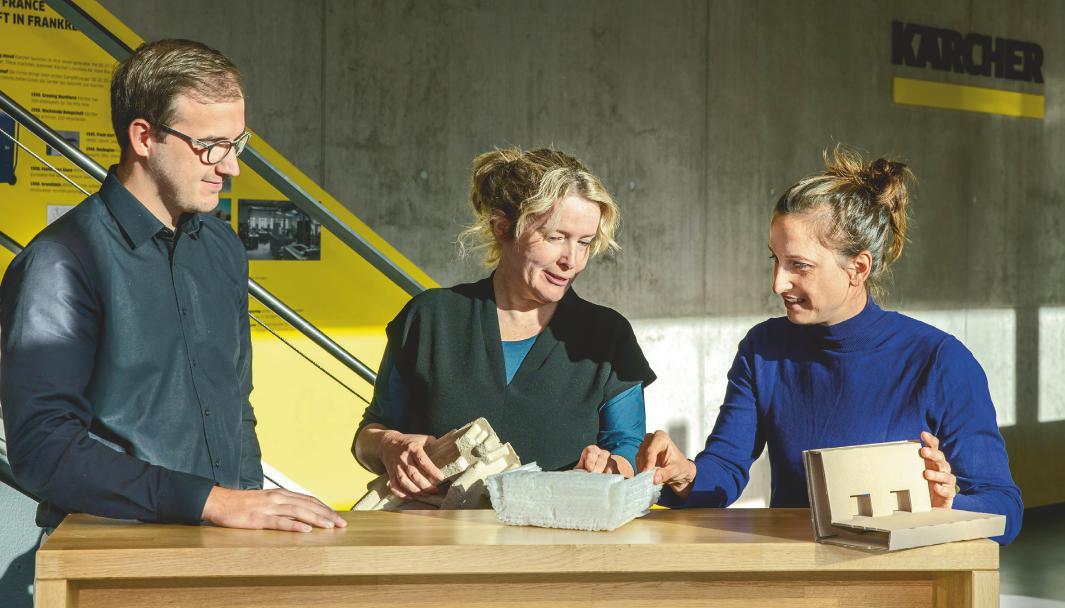
SUSTAINABLE CLEANING
22 | February/March 2024 | ECJ
SUSTAINABLE CLEANING
consumer recycled plastic,” she said. “This reduces CO2 emissions and removes physical plastic pollution. And our products are super-concentrated which means the customer gains more uses from a single container.”
Jangro encourages its customers to retain and refill their sprayers and trigger pump bottles to help reduce plastic consumption. “We also recently introduced our Return, Reuse, Recycle boxes which can be given back to the local distributor when they are no longer required and recycled into something new.”
GOJO, which specialises in hand hygiene solutions, has launched its our own sustainability manifesto entitled Journey to Green. “It sets out clear goals which include how we can minimise waste and help our customers to do the same,” said managing director Chris Wakefield.
“We focus on product design to solve the problem of single-use plastic and achieve zero waste. We use post-consumer recycled polyethylene terephthalate in our collapsible refill cartridges and we aim to achieve a 30 per cent reduction in the use of virgin plastic by 2025.”
So reducing waste during everyday operations is a core aim for many cleaning industry companies. But what other wastereduction schemes do they have that reflect a more innovative, outside-the-box thinking?
Upcycling scheme
Kärcher has introduced an upcycling initiative in Romania whereby plastic scraps that are no longer suitable for product manufacturing are processed into transport boxes. “This significantly reduces both the amount of waste produced and the effort required for the packaging process itself,” said Marie Kristin Schmidt.
Cleanology equips its employees with uniforms made from recycled plastic, says Dominic Ponniah. “This saves 7,000 bottles from landfill each year while also reducing the resources and energy required to manufacture new clothing,” he said.
Hylab provides all its employees with reusable water bottles and mugs as well as filtered water on tap. “This reduces the need for them to purchase water bottles and minimises the waste this involves,” said Joshua Edwardes.
And Greenspeed integrates waste reduction into its IT choices, says Rosaliene Verhoef. “We choose refurbished PCs and laptops to contribute to the circular economy, and we recycle non-functional ones for spare parts to minimise the environmental impact of electronic waste,” she said.
L’élimination de déchets constitue l’un des grands problèmes de toute industrie, si bien que les entreprises acquises à la durabilité font de leur mieux pour minimiser la quantité de déchets qu’elles produisent. Nous interrogeons des fabricants pour savoir ce qu’ils font pour limiter leurs déchets et prenons connaissance des différents dispositifs qu’ils utilisent en vue de réutiliser et recycler leurs déchets, ou les transformer en biocarburants ou autres produits.
Abfall ist eines der größten Probleme, mit denen sich heutzutage jede Branche konfrontiert sieht, und nachhaltige Unternehmen werden ihr Bestes tun wollen, um die Abfallmenge, die sie produzieren, zu minimieren. Wir fragen Hersteller nach ihren Bemühungen zur Abfallbegrenzung und erfahren, über welche Systeme sie für die Wiederverwendung, das Recycling oder die Umwandlung ihrer Abfälle in Biokraftstoffe oder andere Produkte verfügen.
I rifiuti sono uno dei problemi più grossi che qualsiasi industria deve affrontare al giorno d’oggi e le imprese sostenibili vogliono fare del loro meglio per minimizzare la quantità dei rifiuti che producono. Chiediamo ai produttori come si impegnano a limitare i rifiuti e scopriamo i vari regimi che hanno in atto per riutilizzare, riciclare o trasformare i loro rifiuti in biocarburanti o in altri prodotti.



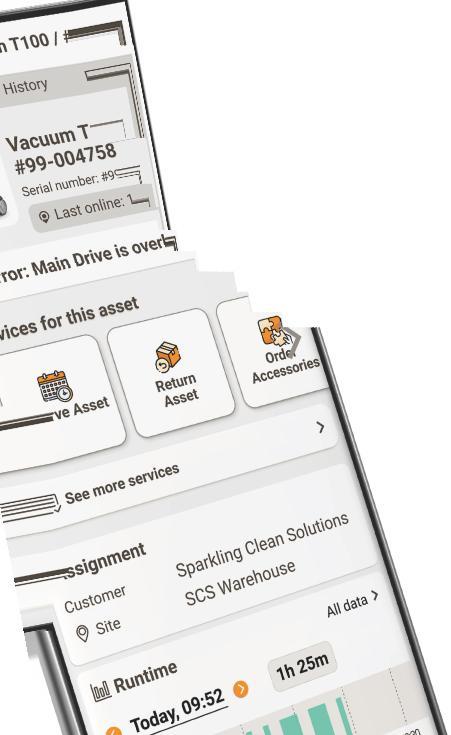
February/March 2024 | ECJ | 23

PRODUCTS: SUSTAINABLE CLEANING
Modern bins
The EnviroEdge Series is a range of contemporary recycling bins in brushed stainless steel or powder coated steel. Made by Leafield Environmental the new models have a narrow footprint, making them suitable for offices with limited space, for example.
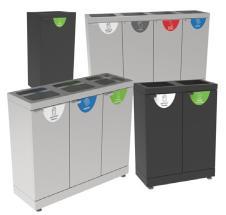
Four different bin sizes are available - single (60 litres), double (2x45 litres), triple (3x45 litres) and quadruple (4x45 litres). For ease of emptying there is a magnetic hidden catch front door opening - there’s an open aperture and internal liner as standard, with an optional lift lid.
WRAP compliant recycling labels are recommended to minimise contamination or bespoke graphics, logos and colour schemes are available upon request. Sleek hidden hinges make it easy to clean and the feet are adjustable.
www.leafieldrecycle.com
Non toxic
Ownwell is a 100 per cent chemical-free and non-toxic microbe tablet that can be used for both manual and machine-
• La série EnviroEdge de Leafield Environmental comprend des poubelles de recyclage en acier brossé ou en acier à revêtement poudre.
• La solution Ownwell est une formule non toxique pour le nettoyage à main ou par machine.
• TTS affirme que sa serpillère Microred porte l’écolabel UE, est fabriquée en utilisant de l’énergie solaire.


based cleaning. This blend of purified tap water and natural microbes leaves no chemical residues behind on surfaces and no harmful compounds are released into the atmosphere.
The microbes in the formula break down dirt and remain actively engaged in keeping surfaces clean over an extended period, says Ownwell - while also eliminating odours.
Straightforward use simplifies the cleaning process.
www.ownwell.fi
The 2024 European Cleaning & Hygiene Awards are now open for entry, at echawards.com
Solar energy
Manufactured using only solar energy, TTS’ Microred microfibre mop has earned EU Ecolabel certification as well as ISO 23231 showing a low release of microplastics during machine washing.
Suitable for dry dusting and frequent washing of smooth surfaces with low to medium dirt levels, Microred boasts high collection capacity and high hygiene standards without the use of chemicals.
www.ttsystem.com
• Bei EnviroEdge von Leafield Environmental handelt es sich um eine Produktfamilie von Recyclingbehältern aus gebürstetem Edelstahl oder pulverbeschichtetem Stahl.
• Ownwell ist eine zu 100% chemikalienfreie Reinigungsformulierung für die manuelle und maschinenbasierte Reinigung.
• Laut TTS wird der mit dem EUUmweltzeichen zertifizierte Microred Mopp mit Solarenergie hergestellt.
• La gamma EnviroEdge Series della Leafield Environmental è una linea di contenitori per il riciclaggio prodotti in acciaio inossidabile satinato o acciaio verniciato a polvere.
• Ownwell è una formula detergente prodotta al 100 per cento senza prodotti chimici per le pulizie eseguite a mano o con le macchine.
• La TTS afferma che il suo mop Microred è certificato EU Ecolabel ed è prodotto utilizzando energia solare.
24 | February/March 2024 | ECJ
PRODUCTS: SUSTAINABLE CLEANING
Probiotic solutions
HTS BIO Laboratories specialises in the development and production of microorganism-based solutions for the cleaning industry. The company has invested in bioreactors which it says play a pivotal role in crafting advanced probiotic solutions, providing environmentally friendly formulas.

HTS BIO studies, purifies, produces and deploys hundreds of different bacterial strains to be used for various applications - for example surface cleaning, drains and grease trap treatment. The aim is to integrate preventive performance into the overall product performance. Once microorganisms
are deposited on surfaces they continue to actively eliminate dirt over time.
www.htsbio.com
Max engineered
Vileda Professional developed its Max mops to enhance its UltraSpeed Pro, CombiSpeed Pro, and Express Pro floor cleaning systems. Made from over 35 per cent recycled materials they can be laundered up to 500 times.
The r-Trio Max is for heavily soiled floors and features scrubbing, microfibre, absorbent and low-friction zones. r-MicroLite Max, meanwhile, is extra large, fully recyclable and suitable for efficient corner and skirting

board cleaning. And r-MicroSpeed Max features a 4D structure - combining microfibre and scrubbing zones, water channels and asymmetric outer loops.
www.vileda-professional.com
For windows
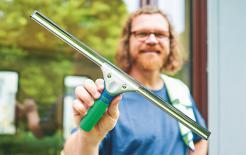
Green Label is a sustainably certified range of window cleaning products from Unger. Alongside the previous squeegee rubbers and window squeegees are a squeegee S-channel, squeegee T-bar, a bucket and a liquid.
Depending on the resources used, Green Label products carry the FSC certificate, the Cradle to Cradle Material Health Certificate or the EU Ecolabel.
www.ungerglobal.com






































• HTS BIO se spécialise dans le développement de solutions à micro-organismes pour applications de propreté.
• Les Max Mops de Vileda Professional sont fabriqués à 35 pour cent en matières recyclées.
• Unger a développé la gamme Green Label de produits certifiés durables pour le lavage de vitres.
• HTS BIO ist spezialisiert auf die Entwicklung von Reinigungslösungen auf der Basis von Mikroorganismen.
• Max-Mops von Vileda Professional bestehen zu mehr als 35% aus recycelten Materialien.
• Unger hat das Sortiment Green Label entwickelt, um Produkte mit zertifizierter Nachhaltigkeit für die Fensterreinigung zu gewährleisten.
• La HTS BIO è specializzata nello sviluppo di soluzioni a base di microorganismi per le operazioni di pulizia.
• I mop Max Mops della Vileda Professional sono prodotti con oltre il 35 per cento di materiali riciclati.
• La Unger ha sviluppato la gamma Green Label per garantire prodotti certificati sostenibili per il lavaggio delle finestre.





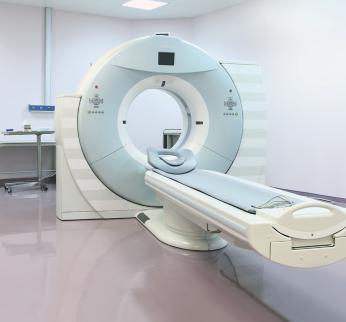


February/March 2024 | ECJ | 25
PRODUCTS: SUSTAINABLE CLEANING
Label milestone
Natural based
• Les chariots polyvalents Alpha de Filmop ont des composants en matière plastique ayant la certification de matières plastiques de seconde vie.
• Wecovi a joué un rôle indéniable dans l’apport de solutions de nettoyage durables, telles que le BubbleFlush, son outil de nettoyage de toilettes, au marché actuel.
• Le nettoyant naturel actif de Kärcher, le RM 82N alcalin, est un détergent qui s’utilise sur des appareils de nettoyage haute pression, et qui est fabriqué à cent à partir d’ingrédients végétaux.
• Numatic sélectionne des matériaux et procédés de nature aussi durable que possible afin de proposer des produits capables de durer.
• La gamme Green Line de housses de balayage humide Vermop est faite en grande partie de matières recyclées.
• L’aspirateur VP300 R de Nilfisk est fabriqué à 30 pour cent en matériaux recyclés après consommation.
• Die Mehrzweck-Reinigungswagen Alpha von Filmop werden aus Kunststoffkomponenten mit PSVZertifizierung (Plastic Second Life) hergestellt.
• Wecovi hat maßgeblich dazu beigetragen, nachhaltige Reinigungslösungen wie das Toilettenreinigungssystem BubbleFlush auf den Markt zu bringen.
• Kärchers Natürlicher Aktivreiniger, alkalisch RM 82N, ist ein Reinigungsmittel für Hochdruckreiniger, das zu 99 % aus pflanzlichen Inhaltsstoffen hergestellt wird.
• Numatic ist bestrebt, Materialien und Prozesse auszuwählen, die so nachhaltig wie möglich sind, um Produkte zu entwickeln, die auf Langlebigkeit ausgelegt sind.
• Die Produktfamilie Green Line mit Moppbezügen von Vermop weist einen hohen Anteil an recycelten Materialien auf.
• Der Staubsauger VP300 R von Nilfisk besteht zu 30% aus Recyclingmaterial, PCR.
• I carrelli multifunzioni Alpha della Filmop sono prodotti con componenti in plastica certificata PSV – Plastica Seconda Vita.
• La Wecovi ha dato un contributo fondamentale nell’immettere sul mercato delle soluzioni di pulizia sostenibili come per esempio lo strumento di pulizia per le toilette BubbleFlush.
• Natural Active Cleaner alkaline RM 82N della Kärcher, un detergente adatto ad essere usato con le idropulitrici ad alta pressione è prodotto per il 99 per cento con ingredienti di origine vegetale.
• La Numatic si impegna a selezionare materiali e procedimenti il più sostenibili possible creando prodotti costruiti per durare a lungo.
• La gamma di coperture per mop Green Line della Vermop vanta una alta percentuale di materiali riciclati.
• L’aspirapolvere VP300 R della Nilfisk è prodotto con il 30 per cento di materiali post-consumo, PCR.
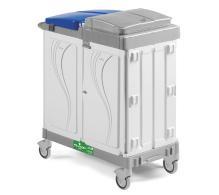
Filmop has achieved EU Ecolabel certification for some of its Alpha wheeled cabinets. Made partly from plastic components certified PSV - Plastic Second Life - the cabinets are made of separable materials that are fully recyclable at the end of their life.
Modular design featuring components that are easy to disassemble and replace makes for long service life, resulting in less use of materials. And no heavy metals such as hexavalent chromium or tin are used.
Certified models include three Alpha multipurpose wheeled cabinets and two Alpha Hotel cabinets. www.filmop.com
Toilet cleaner
As well as developing sustainable cleaning materials, Wecoline promotes innovations such as BubbleFlush, a toilet-cleaning tool that operates without use of chemicals by harnessing the power of water.
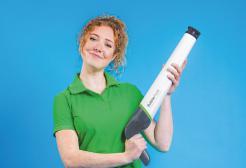
The device produces bubbles in the toilet bowl, using cavitation to naturally clean the toilet. The bubbles implode, removing dirt and scale. The Water Stop component is inserted into the toilet, the toilet is flushed once and the water remains there. This allows the BubbleFlush to clean up to the edge and below.
Both the BubbleFlush and the Water Stop can be carried in the soft case provided - which can also be attached to a trolley.
www.wecoline.com
Kärcher’s latest detergent for use with high-pressure cleaners, cup foam lances or spray units is made from up to 99 per cent natural-based ingredients. Natural Active Cleaner, alkaline RM 82N is a concentrated formula for removing oils, greases, mineral and organic matter.
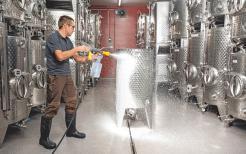
Suitable for use in a wide range of applications, the surfactants in the detergent are easily degradable and over 85 per cent of the ingredients are plant-based. Free of mineral oils, silicone oils, fragrances and dyes, it is easy to separate and gentle on surfaces thanks to the noncorrosive formula. It can work at low water temperatures as well as with hot water high-pressure cleaners at up to 90°C.
www.karcher.com
Built to last
Numatic says product lines are built to be durable, using materials and processes that are sustainable. It developed its own ReFlo technology that uses the highest quality, recycled, post-industrial plastics from the automotive industry, which are otherwise diverted from landfill or incineration.
Alongside the VersaCare ReFlo Janitorial Range, the CleanCare ReFlo Vacuum Series consists of six models including the ERP180 Eco ReFlo Vacuum and PRP180 ReFlo Vacuum which are sustainably engineered and made from a minimum 45 per cent recycled plastic.
The ERP180 is also part of Numatic’s Eco ReFlo vacuum range, which means it’s
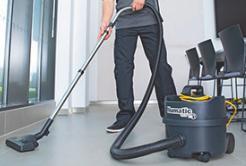
equipped with the 420W energy efficient, high-performance, long-life motor.
www.numatic.com
Blended yarn
Vermop offers the Green Line mop cover range. The Green Basic consists of more than 20 per cent recycled material and is made of a cotton/polyester blended yarn.
Green Brush Progressive, meanwhile, is a polyester flat mop made from up to 60 per cent recycled materials - bristle strips support mechanical dirt dissolution even in edge areas and joints says Vermop.
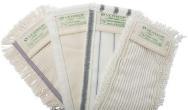
Made from 65 per cent recycled materials is Green Tronic, designed to be an all-rounder for daily use. Green Magic, meanwhile, is a polyester flat mop made of up to 80 per cent recycled material while Green Universal One has up to 40 per cent recycled materials.
www.vermop.com
Recycled plastic
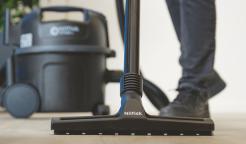
The VP300 R vacuum cleaner from Nilfisk is made from 30 per cent post-consumer material, PCR, a more sustainable type of recycled plastic.
PCR is made from plastic waste like bottles, packaging, containers from households etc, and helps reduce the overall plastic waste with a higher environmental impact compared to post-industrial plastic.
Designed for everyday use in applications such as offices, hotel rooms and retail outlets the VP3000 R is fitted with a HEPA filter, weighs 5.2 kg for easy transport and has a noise level of 5 dBA to make it suitable for daytime cleaning.
www.nilfisk.com
26 | February/March 2024 | ECJ
PRODUCTS:
Keep it simple
Dry steam is a truly green method of cleaning, says OspreyDeepclean, as it keeps things simple. Cold clean tap water is superheated to up to 180°C and surfaces are sanitised and deep cleaned with minimal effort, and without use of chemicals.

Osprey also developed the battery-powered dry steam units GB1 and GB Eco which are part of its GumBusters range. These machines cost effectively remove gum one deposit at a time, with one battery charge lasting up to five hours. Silent operation means they can be used in populated areas. www.ospreydc.com
Carbon neutral
According to Essity, its Tork brand is the first in Europe to reduce and compensate carbon emissions for the entire life cycle of selected soap, toilet paper and hand towel dispensers. Essity has achieved this by reducing carbon emissions in the production process and by offsetting the remaining emissions via investments in certified climate projects.
A total of 27 Tork washroom dispensers for soap, toilet tissue and hand towels have now
• L’équipement de nettoyage OspreyDeepclean n’utilise que de la vapeur sèche et se dispense de produits chimiques.
• Essity a entrepris de réduire et de compenser les émissions de carbone sur la vie entière de savons, papiers hygiéniques et distributeurs de serviettes sélectionnés de la famille Tork.
• Salveco, un spécialiste de la chimie à base végétale, a lancé le Salvesafe 15, un désinfectant et dégraissant concentré.
been certified as carbon neutral. These include the Tork SmartOne Toilet Paper Dispenser; the Tork PeakServe Continuous Hand Towel Dispenser; the Tork Coreless Midsize toilet paper system and Tork soap dispensers. Certified renewable electricity is used during production.
Certified climate projects chosen to offset the carbon emissions include the provision of energy-efficient cooking stoves in India and the support of forest protection schemes in Indonesia. These schemes are all being run in conjunction with ClimatePartner.
www.tork.co.uk
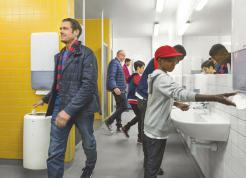
Plant-based
Specialising in plant-based chemistry, Salveco develops 100 per cent green vegetable-based biodegradable products from renewable sources.
The biocidal solutions it offers are based on a patented technology called Effibioz, the goal of which is to decarbonise and substitute fossil fuelbased chemistry with plants. The concentrated disinfectant and degreaser Salvesafe 15 is the company’s latest product, whose active ingredients guarantee the elimination of 99.9 per cent of bacteria, yeasts and encapsulated viruses.
salveco.fr
• OspreyDeepcleanReinigungsgeräte verwenden nur Trockendampf und erfordern keine Chemikalien.
• Essity reduziert und kompensiert die CO2Emissionen während des gesamten Lebenszyklus ausgewählter Tork Seifen-, Toilettenpapierund Handtuchspender.
• Salveco, der Spezialist für Pflanzenchemie, hat das konzentrierte Desinfektions- und Entfettungsmittel Salvesafe 15 auf den Markt gebracht.

• Le unità di pulizia della OspreyDeepclean utilizzano solo vapore secco senza necessità di usare prodotti chimici.
• La Essity sta riducento e compensando le emissioni carboniche per l’intero ciclo di vita di dispenser selezionati di saponi, carta igienica e asciugamani Tork.
• La Salveco, specializzata in chimica a base vegetale, ha lanciato il disinfettante concentrato e sgrassante Salvesafe 15.

February/March 2024 | ECJ | 27
SUSTAINABLE CLEANING

Opportunity to transform
The impact you have on the world is changing. Are you taking advantage of it? As an industry, we need to change how we think and talk about cleaning, says Malene Thiele, global director, ESG & sustainability at Nilfisk. Global warming and the extreme weather events often linked to it are key reasons why. Because no matter where we live, we’ve entered an era of extreme weather. Along with its challenges, extreme weather brings transformation and changes the impact of our industry. She tells us why in the first of an exclusive series of articles for ECJ.
WHEN I BROWSED through the aisles of the CMS international trade fair for cleaning and hygiene in Berlin last year, I was bombarded with solutions to clean just about anything more sustainably. There were demonstrations, testimonials and functional sustainability guarantees. This product would save me that amount of electricity, water, or detergent. Or that product was made with this percentage of recycled plastic.
And that’s a good place to start. But it’s far from where we must go. Yes, our products and service offerings need documented, radically enhanced sustainability profiles. It is the least that customers can expect of our industry – and the least that we can expect of ourselves.
However, focusing only on the functional aspects of our products when it comes to sustainability merely scratches the surface of a powerful environmental agenda. What’s more, it vastly underestimates the powerful business potential of that agenda.
In addressing climate change we play an important role as an industry, both in mitigation and in adaption. The World Economic Forum’s 2023 ‘Future of Jobs’ survey furthermore shows that businesses predict the strongest net job-creation effect to be driven by investments that facilitate the green transition of businesses, a broader application of environmental, social and governance (ESG) standards, and more localised supply chains.
Extreme weather
In my opinion expanding our focus on sustainability is a task we cannot afford to ignore. Because the winds of change have, quite literally, begun to blow.
The era of extreme weather has begun. During the summer of 2023, did you at some point think “What is up with this weather?“ Not just in Europe, but all over the world, this past summer set some disturbing global records. According to scientists at NASA, it was Earth’s hottest summer since global record keeping began in 1880.
But the summer of 2023 wasn’t just a scorcher. If June and July were hot, August was windy. Then September was wet, and when it rained it poured. Rain fell in volumes rarely seen in the Mediterranean region, causing floods and extreme downpours elsewhere.
The thing is, we need to get used to these types of extreme weather events – even the thunderstorms that in July dumped hail the size of tennis balls in Italy. With global warming and El Niño, we have entered an era of extreme weather.
Where does this leave the professional cleaning industry? In what could be a very impactful place indeed, I think.
Clean is changing
Our industry’s impact on the societies and communities we serve is changing.
With global warming and more extreme weather events, our customers need swift, reliable cleaning for more reasons than ever:
• To limit the damage caused by extreme weather
• To limit the spread of infectious diseases
• To safeguard our customers’ customers and employees.
When it comes to cleaning, we are not only selling clean environments. We are also selling safe and operative environments. We are selling resilience. Stability. Uptime.
Our products and services help our customers to keep their facilities up and running – which is especially important in times of extreme weather. Although the societal impact and importance of the cleaning industry is increasing on a deeply concerning background, it IS increasing. The era of extreme weather will change the world’s cleaning needs. And with that our industry.
The value of a new industry purpose includes attracting and keeping talent. Consequently, our industry needs to change how we think and talk about cleaning. But why is that valuable? How will it make our industry more successful?
SUSTAINABLE CLEANING
28 | February/March 2024 | ECJ
Say we’re able to spread the word about how we impact society and the value we bring within sustainability. So what?
One positive effect is that we can make our industry much more attractive to diverse talent. If we successfully communicate our role, we can make our industry more engaging. More driven by a higher, valuable purpose.
Why do YOU go to work? To earn a living, of course. But it can and should be about more than that. You are not only helping your customers keep their premises clean. You are also helping them stay safe and operative.
In the face of extreme weather, this industry will become a pillar of societal resilience and stability. We will help make the world a safer place. Our industry is about more than just products and their functional performance. When we tap into the greater purpose of this industry, we can make recruitment and retention easier.
I believe we can make our value to society widely heard and acknowledged. And in doing so, we can attract even more talented people who want to make a difference. We are sitting on a formula that may transform our industry from within.
Perhaps you are interested – now what? There’s no doubt that it’s far easier to talk about transforming our industry with a new, sustainable purpose than it is for any of us to act upon. Consider these words a seed planted. And like any seed, it will take time to grow.
True commitment
Clearly, each of us must find what suits our unique circumstances. For some that will mean an urgent look at the company’s product development strategy, marketing practices, and internal and external communication. For others it will prompt a new, permanent point on the agenda of upcoming management meetings. Still others may be asking their key suppliers how they work to mitigate their effect on global warming.
I invite anyone who is interested in learning about Nilfisk’s work with sustainability to read our 2023 sustainability report and reach out to us at sustainability@ nilfisk.com. Depending on the situation, we can explore potential synergies, activities, questions and answers and – who knows – take steps to nurture the transformation of our industry together.
We must show true commitment to mitigating our impact on global warming. You may be thinking: “but is it wrong to try to benefit from the negative effects of global warming?”
I will answer that question with another. Is it wrong to profit from alleviating a negative situation, essentially solving problems big or small with a commercial solution? Of course not.
But it will, of course, be crucial that companies commercially leveraging this higher purpose do whatever is expected – and more – to mitigate their own impact on global warming. Otherwise, one could be seen as selling the medicine for a disease one helps spread.
This new industry position, which communicates how we enable resilience in the face of extreme weather, must include a deep commitment to combatting climate change. One cannot exist without the other.
Likewise, our industry cannot thrive without addressing the task climate change presents. And the world cannot thrive without the resilience our industry’s equipment and people provide.
Let’s transform our industry. Together.

En tant que membres de cette industrie, il nous incombe de changer la manière dont nous entrevoyons la propreté. Certes, il faut que nos produits et services s’assortissent de profils de durabilité rehaussés et documentés. Cependant, il ne faut pas uniquement se concentrer sur les aspects fonctionnels des produits face à la durabilité, car le dossier environnemental est bien plus vaste. Malene Thiele, directrice mondiale du service ESG et durabilité de Nilfisk, commence une série d’articles exclusifs pour ECJ.
Als Branche müssen wir ändern, wie wir über Reinigung denken und sprechen. Natürlich benötigen die Produkte und Serviceangebote dokumentierte, verbesserte Nachhaltigkeitsprofile. Wenn man sich jedoch nur auf die funktionalen Aspekte von Produkten konzentriert, wenn es um Nachhaltigkeit geht, kratzt man lediglich an der Oberfläche einer wirkungsvollen Umweltagenda. Malene Thiele, Global Director, ESG & Sustainability bei Nilfisk, startet eine neue exklusive Artikelreihe des ECJ.
Come industria, dobbiamo cambiare il modo di pensare e di parlare delle pulizie. Sicuramente i prodotti e le offerte di servizi hanno bisogno di profili di sostenibilità documentati e migliorati. Tuttavia, concentrarsi solamente sugli aspetti funzionali dei prodotti quando si tratta di sostenibilità sfiora solo in maniera superficiale il piano ambientale potentissimo. Malene Thiele, direttrice globale, ESG & Sostenibilità per la Nilfisk inizia una nuova serie esclusiva di articoli per ECJ.
SUSTAINABLE CLEANING February/March 2024 | ECJ | 29
Sustainable cleaning goals - Fimap’s journey

FOver the past year, Fimap has reached a number of new milestones in its quest for sustainability, with both the company and the products achieving recognition.
rom ISO 14064-1:2018 certification to the EcoVadis Gold Medal and the ReMade in Italy recycled plastic certification, Fimap has demonstrated clear intentions with regard to how the company will pursue the directives set out in the 2030 Agenda.
These achievements, along with the previous goals and certifications attained, cannot be improvised: rather, they are results that are reached over time, through the adoption of a method that starts upstream, taking all possible consequences for the environment into consideration.
SUSTAINABILITY BEGINS WITH AN IDEA
The impact of the products manufactured is largely dependent on decisions made at the design stage. This is where we establish how to make a durable product that is easy to maintain and repair. This is where the materials are chosen, where any recycled parts are integrated, and where disposal is facilitated. And it is also the moment at which we look at not only how to make a product easy to use, but above all, how to make it easy to use in an efficient manner, whilst saving resources. All of these assessments are essential, because peak improvement can only be achieved if the entire life cycle of the machine is taken into account; as such, it is a process that involves all parties, from the suppliers to the end users.
CERTIFIED RECYCLED PLASTICS
Fimap has worked with its suppliers to implement a project designed to recover
plastic waste and turn it into a valuable resource. This led to the creation of our recycled plastics, which have subsequently received ReMade in Italy certification. Meanwhile, in order to involve the end users of the machine, it is necessary to focus on the activity phases, which include both use and maintenance. The support of technology which is both accessible and dynamic enables users to draw maximum benefit, taking advantage of the machine’s features and changing their behaviours, and as a result, their cleaning style. Accordingly, users are drawn to make more responsible choices, facilitated by Fimap. All it takes is the push of a button to reduce the use of resources, recycle these and activate complete work programmes that prevent waste.
Proper maintenance is all it takes to keep the machine in optimal condition and extend its working life. In order to avoid mistakes, the user can also access on-board video tutorials. Having analysed the life cycle and identified the areas for improvement, Fimap has succeeded in designing an environmentally-friendly product and developing upstream solutions that ensure that it continues to be sustainable during use once in the hands of the customer.
NEW TECHNOLOGIES FOR SAVING RESOURCES
It is therefore clear that buying a Fimap product also signifies accepting a new way of working, rendered more efficient by technology, which anyone can put into practice, precisely because it is so simple: the touch of a button is all that is required. Throughout its history, Fimap has always
A NEW GENERATION MACHINES
COMMITTED TO
ZERO EMISSIONS

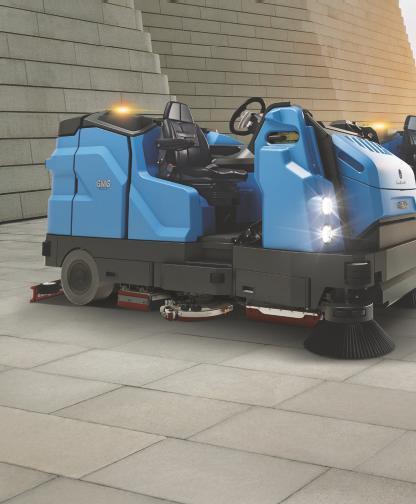
sought to go above and beyond, offering technological solutions designed to protect the environment and resources. This year, the company’s innovations are focused on water, with AQUÆ® technology, and air, with Safe Air technology.
FOR DETERGENT-FREE CLEANING
AQUÆ® aims to eliminate the use of detergents. A cleaning and sanitising solution with a long-lasting effect is obtained simply by activating the chlorine in softened tap water.
This prevents all of the pollution generated by the use of detergents, from the plastic used to contain it to its transportation and the surfactants released in waste water.
The sheer breadth of application makes this technology even more extraordinary: it is perfect for the daily and maintenance cleaning of buildings, which constitutes around 90% of operations in the professional cleaning sector.
BETTER QUALITY OF THE AIR RETURNED TO THE ENVIRONMENT
Meanwhile, the Safe Air technology is designed for sweeping machines, with a view to improving the quality of the air in the spaces being cleaned, so that they are safer for the people who spend time in these environments.
Once sucked into the system, the air passes through several types of filter, which retain increasingly small dust particles, right down to
world
ENVIRONMENT

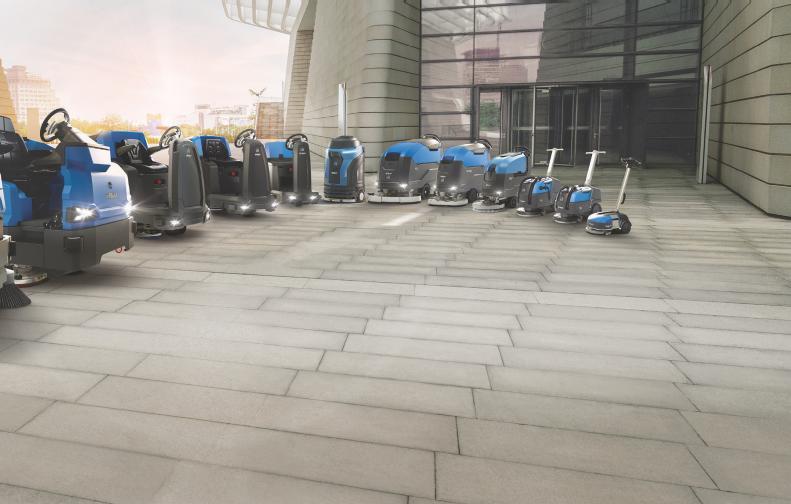
0.3 µm: these are captured by the Hepa filter, which has a filtration efficiency of 99.9%.
FFM - FIMAP FLEET MANAGEMENT ENVIRONMENTAL IMPACT CONTROL
One element that Fimap has never underestimated is control. Since its introduction, the FFM - Fimap Fleet Management system has provided customers with the ability to remotely monitor cleaning operations, enabling them to see how these are being performed without needing to be present. It is the most accurate tool for obtaining detailed information on the machines, from the way they are used to their consumption of resources and the CO2 produced by each operation. These data constitute an essential foundation for creating strategies for improvement, and in the specific case of CO2, to implement steps to compensate and neutralise this. Today, the system is even more advanced, with two new functions: INDOOR TRACKING and MISSION CONTROL PART PROGRAM. The first function tracks the movements of the machine within buildings, so that supervisors can see which spaces have already been cleaned and which are still to be completed,

as well as staying up-to-date on the progress of the cleaning plan. Meanwhile, the Mission Control Part Program enables a weekly cleaning schedule to be set and sent to the machine. Any operator tasked with carrying out the cleaning operation simply needs to press the button that lights up on the display in order to start the machine with the set parameters. It prevents incorrect settings as well as the misuse and waste of resources. It also avoids the need for training, with the associated time and costs.
CERTIFYING THE LIFE CYCLE OF THE PRODUCT
Carbon Footprint of the Product, CFP 14067:2018 Systematic Approach
In the life cycle analysis, the use phase has always been the most difficult to ascertain, due to the wide range of variables. The synergy between environmental technologies and the FFM system has made it possible to recover this piece of the puzzle, completing the analysis with scientific, verifiable data. This has led to the achievement of CFP - Carbon Footprint of Product Systematic Approach certification for scrubbing machines, used to calculate the amount of CO2 produced by the individual
world
machine per hour of work, obtaining a certified figure in line with ISO 14067:2018.
CERTIFYING THE ENVIRONMENTAL PROCESSES
Carbon Footprint of the Organisation, 14064-1:2018
Certifications enable internal progress to be communicated externally using a shared language. Customers are increasingly focused on the environmental value of a given product and company, and seek certifications as tangible evidence. These certifications link the efforts of bodies, companies, suppliers and end users, as they work together to achieve the goals of the 2030 Agenda.
Fimap’s unwavering focus on these issues over the years has led to the company being awarded the EcoVadis Gold Medal, which recognises the excellent performance across the company, as well as the CFO - Carbon Footprint of Organisation evaluation, which certifies greenhouse gas reporting in accordance with ISO 14064-1:2018.
SUSTAINABILITY REPORT
Each individual certification, from those pertaining to products to those regarding the company, represents a specific point of view on sustainability. As such, Fimap has decided to offer an overview of everything it has attained, voluntarily compiling its first Sustainability Report, which describes the company’s achievements and maps out the goals that await it in the near future, declaring its commitment to continue to improve by following the objectives of the 2030 Agenda.




ENVIRONMENTAL IMPACT MONITORING TO CLEAN WITHOUT DETERGENT IMPROVED AIR QUALITY CERTIFIED RECYCLED PLASTIC EFFICIENT ENERGY USE
www.fimap.com
ISO 14064-1:2018
ISO 14067:2018
CARBON FOOTPRINT OF ORGANIZATION
CARBON FOOTPRINT SYSTEMATIC APPROACH the video AQUÆ®
Watch ENVIRONMENT Read the Sustainability Report Visit us at INTERCLEAN Amsterdam Netherlands - RAI Amsterdam 14/17 May 2024 Hall 1 Booth 01.421B
Washroom strategy

With reports suggesting consumers are looking for more eco-conscious products, Alasdair Sharp from Satino by WEPA explains how facilities managers can curate a more sustainable hygiene strategy to help achieve the EU’s goal to be climateneutral by 2050.
are more alternatives than ever for quality, sustainable, hygiene papers. With the increasing availability of more responsible options, washroom products do not have to come at the detriment of a facility’s green goals.
The pulp and paper industry uses between 33-40 per cent of all industrial wood traded globally. It is a major contributor to deforestation and thereby, to biodiversity loss, species extinction and ecosystem disruptions. Deforestation laws are becoming stricter across the EU, so the importance of alternative fibres is clearer than ever.
touch-free tech is the reduced number of touch points, helping to limit the risk of spreading germs in the washroom.
AS ENVIRONMENTAL STRATEGIES take centre stage within businesses, one area that may be overlooked is the washroom. Before it’s too late to revert the impact of climate change, businesses must focus on environmental strategies. Highlighted by COP 28 in December 2023, the push to limit the global temperature rise to 1.5 degrees Celsius is more pressing than ever.
The UN Global Compact-Accenture CEO Study on Sustainability found that 84 per cent - of the 1,000 global CEOs surveyed - thought businesses should lead efforts to address global issues, such as environmental damage. Facilities managers need to meet carbon and waste reduction targets by operating a planet-first approach.
Hygiene strategies aren’t often considered within sustainability targets, however, they can have a significant impact.
Focusing on the washroom is an accessible way for any business to reduce plastic waste and energy usage.
Pioneering planet-friendly fibres
Hygiene paper used in washrooms is an easy place to start when looking at reducing environmental impact. The paper industry is among the top five most energy-intensive industries and accounts for approximately two per cent of direct industrial CO2 emissions. This has driven innovative advancements meaning there
Papers made from old corrugated cardboard (OCC) represent the latest revelation from the paper industry in battling deforestation. The production process for turning OCC into paper uses less energy and water compared to methods using raw materials. This is because the shredding and pulping phases are powered by renewable energy sources.
Corrugated cardboard has fibres that are well-suited for recycling, as it is typically made from premium fibres that have already undergone processing. These fibres retain their strength and length, resulting in robust products with a high level of quality and durability.
By choosing hygiene papers made from OCC, facilities managers will boost their eco-initiatives, as they are helping to keep valuable materials within resource streams, contributing to a more circular economy. When it comes to a facility’s sustainability strategy, the impact a change like this can have on its success is invaluable.
Optimising energy efficiency
Reducing our energy use benefits the economy whilst simultaneously driving sustainability strategies. Touch-free technology is a valuable asset to reduce energy usage in the washroom and can be used for many functions. Touch-free taps that operate on timers help prevent water wastage, offering an environmentally friendly solution. A bonus benefit to
Touch-free technology is also being used more frequently in the production of paper and soap dispensers. By dispensing the optimum amount of hygiene papers or soap, stock levels are prolonged and over-consumption is prevented. Copious amounts of waste and purchasing vast numbers of supplies can be detrimental to a facility’s sustainability targets, so touch-free technology can be the key to achieving a more planet-friendly facility. As well as limiting damage to the environment, this sustainable solution to energy efficiency also limits expenditure on bills. Along with reducing water waste use, touch-free tech such as motion sensor lights can help conserve energy by ensuring that lights aren’t left on unnecessarily. This also helps prolong the life of light bulbs, reducing the amount of waste produced from the frequent replacement of light bulbs.
Creating a plastic-free path
Twelve million tonnes of plastic finds its way into the ocean every single year, which equates to eight million pieces of plastic entering the ocean every day, having a significant impact on our marine wildlife and food chain. We are all encouraged to recycle, however, due to the varieties of plastic that can’t be recycled together, only nine per cent of global plastic waste is actually being recycled. Switching to plastic-free items is a small change that facilities managers can make to help shrink environmental impact. It’s paramount to keep a conscious eye on not just the products in the washroom, but the packaging they come in.
Reusable packaging and post-consumer recycled plastic packaging (PCR) reduce the need for virgin materials to be extracted and processed, allowing them to remain in the resource stream. Since January 2023, over 40 per cent of the global population has been living in areas where
Continued page 34
SUSTAINABLE CLEANING
32 | February/March 2024 | ECJ
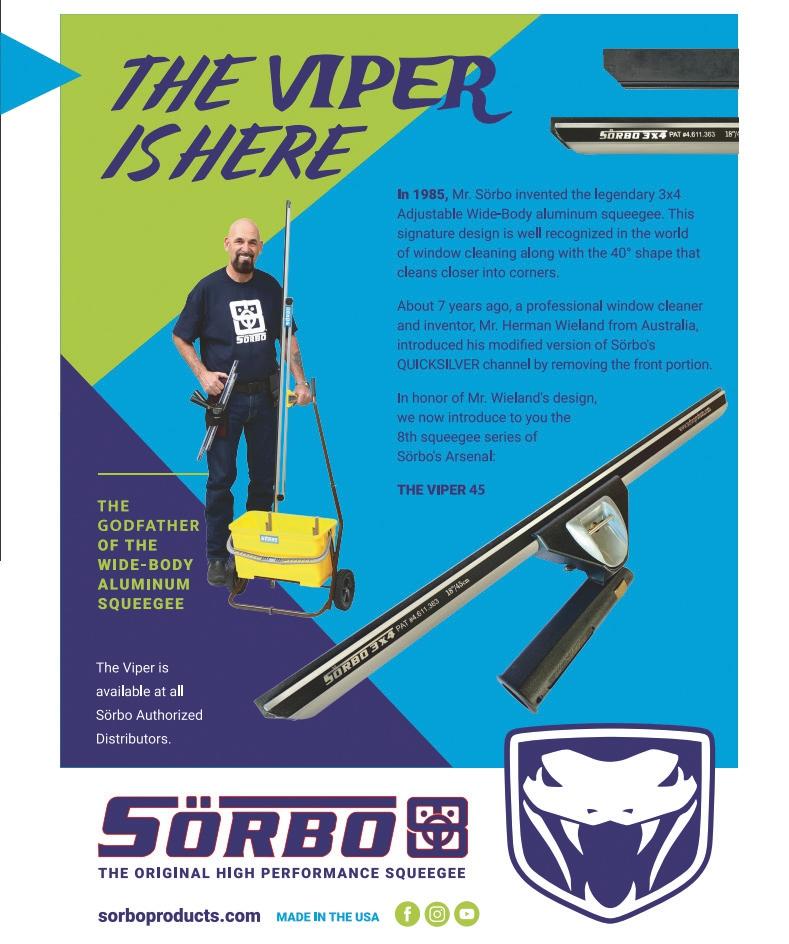
the generation of plastic has surpassed the available capacity for its management.
The actual liquids that are used in the washroom may be considered a less obvious area to target when facilities managers are striving for a plastic-free washroom. However, these are equally important. Synthetic polymers, which are a liquid form of microplastics, are used in many soaps as a binding agent and film former. These harmful plastics present potential physical and toxicological risks to organisms of a range of sizes and pollute our oceans.
Facilities managers should be aware of supplies containing polyethylene, polypropylene and nylon, as these materials can potentially break down into microplastics and are often found in traditional liquid and foam soaps. Fortunately, sustainable alternatives exist. Choose liquid and foam soaps formulated without microplastics or synthetic polymers to build a greener hygiene strategy. By making informed, environmentally conscious decisions about facility supplies, managers can significantly contribute to microplastic reduction.
Navigating eco-certifications and regulations
With the EU and governments across Europe introducing tighter restrictions on plastic usage, prioritising the environment is not only a choice but, in some cases, a legal requirement. As environmental regulations become more stringent, it is essential to recognise eco-certifications and labels to ensure your business remains compliant with evolving standards.
Key certifications/labels:
• Blue Angel: The Blue Angel focuses on the raw materials used and product safety, with the main focus on environmental and health protection.
• EU Ecolabel: The European Ecolabel makes sure that production processes are carried out according to strict environmental standards. It serves as a guide for everyone who wants to protect the environment by means of product choice.
• FSC (FSC-C016151) and PEFC (PEFC/04-32-0775): FSC and PEFC are wood product certifications for wood from sustainable forestry.
• Cradle to Cradle: The Cradle to Cradle
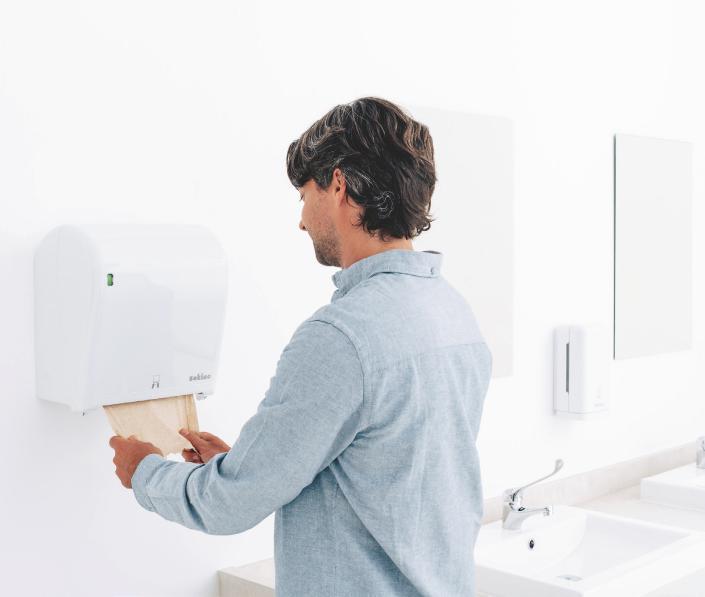
Alors que les stratégies environnementales occupent une place centrale au sein des entreprises, les toilettes sont un domaine qui peut être négligé. Avant qu’il ne soit trop tard pour inverser l’impact du changement climatique, les entreprises doivent se concentrer sur des stratégies environnementales. Alasdair Sharp de Satino by WEPA explique comment les gestionnaires d’installations peuvent élaborer une stratégie d’hygiène plus durable.
Da Umweltstrategien in Unternehmen im Mittelpunkt stehen, wird ein Bereich, der möglicherweise übersehen wird, der Waschraum. Bevor es zu spät ist, die Auswirkungen des Klimawandels umzukehren, müssen sich Unternehmen auf Umweltstrategien konzentrieren. Alasdair Sharp von Satino by WEPA erklärt, wie Facility Manager eine nachhaltigere Hygienestrategie entwickeln können.
(C2C) concept focuses on designing products with less harmful materials, allowing for reuse or natural degradation.
• ISO: ISO 9000 family is a set of five quality management system standards that ensure businesses meet customer and stakeholder needs within statutory and regulatory requirements.
• Dermatest: Dermatest evaluates the skin compatibility of products directly on humans, providing scientifically substantiated confirmation of product tolerance and safety.
Facilities managers look for the FSC Recycled certified stamp when choosing recyclable hygiene products to ensure the paper comes from responsibly managed forests. EU Ecolabel is another key indicator of environmental commitment. This certification provided by the European Union highlights products that meet strict environmental criteria, covering various product categories including personal care and cleaning.
Recycling infrastructure and regulations may vary by region, so it is essential to be aware of local recycling practices to ensure legitimate commitment to improving the recycling standards of a facility. As the EU sets out its aim to become carbon neutral by 2050, facilities will have no choice but to pay careful attention to eco-certifications and adhere to regulations.
Businesses across all sectors know they must act, as time is of the essence in the fight to reduce carbon emissions and waste. Although it may not seem an obvious point of call, targeting the washroom is an ideal way for any business to boost environmental efforts to significantly reduce plastic waste and energy usage. These changes not only benefit the environment but also contribute to cost savings and a heightened sense of social responsibility. As facilities across all sectors have washrooms, implementing a more sustainable hygiene strategy is a simple and accessible way for businesses to boost environmental efforts. By adopting a more eco-friendly approach, businesses will not only benefit the environment and conserve finances, but also demonstrate a commitment to corporate social responsibility.
Poiché le strategie ambientali sono al centro dell’attenzione nelle aziende, un’area che potrebbe essere trascurata è il bagno. Prima che sia troppo tardi per invertire l’impatto del cambiamento climatico, le aziende devono concentrarsi sulle strategie ambientali. Alasdair Sharp di Satino by WEPA spiega come i gestori delle strutture possono curare una strategia igienica più sostenibile.
SUSTAINABLE CLEANING
34 | February/March 2024 | ECJ







On the front line
What are the main challenges facing healthcare cleaning personnel today? And what can be done to make their lives easier?
Ann Laffeaty finds out.
CLEANERS IN THE HEALTHCARE sector have had a tough few years, to say the least. Working throughout the global pandemic was stressful and life-threatening enough, but this was closely followed by the cost-of-living crisis which made it difficult for the lower-paid to make ends meet. And add to this the stringent new cleaning regimes put in place after Covid-19 which forced cleaners everywhere to learn exacting new protocols.
So, how are they coping with the stresses of the job? And what are the biggest challenges they face? The new standards implemented in the wake of Covid have made life particularly tough for healthcare cleaning personnel, according to IPC by Tennant Company sales manager Francisco Ortiz.
“These are causing physical, mental and emotional exhaustion among staff members – particularly when seen against a backdrop of historically poor working conditions and limited professionalisation in the sector,” he said.
Staff shortages are also putting huge pressure on hospital cleaners, says Ortiz. “The demands of the job have become a major barrier to attracting new personnel,” he says. “And this has been compounded by the heightened risks posed by Covid. Consequently, many situations are arising where the workload needs to be distributed among a reduced number of workers, which only exacerbates their discomfort.”
Healthcare cleaners in general often lack adequate training and direction, he believes. “There is a prevailing notion that proficiency in household cleaning will translate into competence in other environments, but the healthcare cleaning
sector requires specialised knowledge and training,” he said.
According to Ortiz the short time-frame often allocated for healthcare cleaning coupled with a lack of appropriate tools and guidance can add huge pressure on operatives. “The right tools and training can significantly enhance efficiency and while time is a critical factor, it is intricately linked to the availability of proper equipment,” he said.
However, it is the historically low rates of pay that pose the main challenge for the sector, he says. “This tends to result in an influx of staff members who may not have optimal qualifications as well as a high turnover of employees,” he said. “And it also discourages any ongoing training and professional development.”
A combination of low salaries, the increased cost of living and additional burdens brought about by Covid has created fatigue and demotivation among healthcare cleaning personnel, says Ortiz.
“This obviously has potential repercussions on their commitment and the quality of their work,” he said. “Working conditions therefore need to be improved to attract new talent and to retain and motivate existing staff. This should involve enhanced training programmes plus the provision of ergonomic procedures and equipment that minimise physical strain on operators while also boosting efficiency.”
Many environments
Healthcare cleaning staff need to adapt to a range of different environments such as patient rooms, operating rooms, waiting areas and laboratories says Kärcher’s senior consultant professional cleaning solutions Gundula Braun. “However, each area has its unique challenges which may include the need for cleaning delicate equipment, sensitive surfaces or hazardous materials that require specialised training,” she said.
“Healthcare settings are also often busy and fast-paced places where operatives have a limited amount of time for thorough cleaning. They therefore need to be
able to work efficiently while also balancing the requirement for a quick turnover of patient rooms and common areas. And these time constraints can have an impact on cleaning quality and increase the risk of cross-contamination.”
She says healthcare facilities need to maintain high standards of cleanliness to prevent the spread of infections. “Cleaning personnel must adhere to strict protocols in order to effectively clean and disinfect surfaces, equipment and patient areas,” she said. “The challenge here lies in staying up to date with evolving infection control guidelines and ensuring a level of consistency in cleaning practices.”
Challenging situations
Another issue is the fact that cleaning staff in healthcare settings are likely to encounter emotionally challenging situations, adds Braun. “These could include cleaning up after traumatic events or working in areas where patients are critically ill,” she said. “Staff therefore need to manage their emotional well-being and cope with the potential stress and psychological impact of their work.”
Staff shortages are an additional challenge, she says. “Healthcare cleaning departments often face staffing shortages or high turnover rates, and limited personnel numbers can lead to an increased workload plus difficulty in maintaining cleanliness standards,” says Braun. “Adequate staffing levels, ongoing training and effective communication are all crucial to addressing this challenge.”
Many healthcare cleaners may also lack adequate training and direction, she says. “The complexity of healthcare environments coupled with the evolving nature of cleaning means that ongoing education and training is required for cleaners,” says Braun. “But keeping up with new guidelines, technologies and best practices can be challenging, particularly if the resources for continuous training are limited.”
Kärcher’s senior consultant professional cleaning solutions Christoph Scheiwiller adds healthcare operatives often have too
HYGIENE IN HEALTHCARE
36 | February/March 2024 | ECJ
little time to thoroughly clean a healthcare setting. “The fast-paced nature of healthcare facilities, combined with the need for a quick turnover and the high demand for cleaning services can leave insufficient time for thorough cleaning,” he said.
“Language barriers are also an issue since that can hinder effective communication between cleaning personnel and their supervisors, co-workers and other staff members. Misunderstandings can then lead to mistakes, delays and inefficiencies because proper communication is essential in healthcare settings for maintaining safety protocols.”
Creating a supportive work environment is crucial to the well-being and job satisfaction of healthcare cleaners, says Scheiwiller. “Comprehensive training and education is essential and should cover proper cleaning techniques, infection control protocols, handling of hazardous materials and the use of cleaning equipment and products,” he said. “And morale and job satisfaction can both be boosted by recognising the efforts of staff through regular feedback, rewards and opportunities for advancement.”
Time and budget are both key issues when cleaning in healthcare facilities, says Essity’s communications director Jenny Turner. “Cleaning needs to be carried out correctly within the established guidelines because lives are literally on the line,” she said. “So it requires a minimum amount of time to accomplish.”
The role of the hospital cleaner is more important than many people realise, she says. “Cleaners are often the people the patient sees the most because they come in every day,” says Turner. “They interact with the patient and make important connections that have a greater impact on the facility than their cleaning work alone.
“And the visible cleaning they carry out provides patients and visitors with peace of mind and reassures them that the facility is hygienic and safe.”
Staff shortages are creating extra pressure on facilities, she says. “Anything we can do to help save cleaners time will enable them to provide those little extra services that enhance the patient experience while also freeing up the healthcare staff to carry out other tasks.”
Quels sont les grands défis des agents de nettoyage qui travaillent pour les services de santé? Se peut-il que des pénuries de personnel, un manque de formation, de fortes rotations de travailleurs, des barrières linguistiques ou un manque de temps d’exécution pénibilisent le travail nécessaire au nettoyage complet d’un établissement de santé?
Quels sont les types de procédés et systèmes à mettre en place pour faciliter ce travail ?
She adds healthcare cleaners must be properly trained in order to carry out their jobs effectively – but finding the time and the resources to train them is always a challenge. “Staff time needs to be focused on the cleaning jobs in hand which means carving out time for training is not always easy. And the fact English isn’t always the cleaner’s first language means there may be a communication issue, particularly where training is concerned.”
Recruitment headaches
The biggest challenge facing healthcare today is the increasing difficulty in recruiting, training and keeping staff according to Greenspeed marketing executive Rosaliene Verhoef. “This means many vacancies remain unfilled which puts a great deal of strain on current healthcare cleaning personnel,” she said. “Unfortunately it also results in lower cleaning frequencies - particularly in non-critical areas such as office spaces within hospitals.”
These staff shortages put hospital cleaners under immense pressure, Verhoef says. “And this understandably impacts on their ability to deliver the highest standards of cleanliness.”
The issue also has a knock-on effect on training, she adds. “Due to high staff turnover, new hires have to be trained on the job each time,” she said. “This contributes to a cycle of insufficiently prepared cleaning personnel while budget cuts have
reduced the time available for training. Moreover, a growing number of staff members face language barriers which adds an additional layer of complexity to an already challenging training situation.”
Cleaners are often given insufficient time to thoroughly clean healthcare settings, she said. “Staff members are expected to be flexible and handle additional tasks, which leaves them significantly less time to thoroughly clean the various departments.”
Like other commentators she believes an increase of non-native speakers into the workforce has created a language barrier problem. “And another issue is that while the number of hospital beds hasn’t changed significantly, the number of patients is increasing,” she said. “These patients tend to stay for a much shorter time in the hospital than before. And this adds a new layer of urgency to the cleaning process since each patient area needs to be thoroughly cleaned every time someone leaves.”
The crux of the matter lies in an urgent need for more training opportunities, Verhoef concludes. “Digital resources such as instructional videos are able to provide accessible and flexible learning options for healthcare cleaners. And allocating more time for on-the-job coaching can further support the development and improvement of any operative’s cleaning skills.”

Was sind die größten Herausforderungen, denen sich das Reinigungspersonal im Gesundheitswesen heute gegenübersieht? Erschweren Faktoren wie Personalknappheit, mangelnde Ausbildung, hohe Personalfluktuation, Sprachbarrieren und zu wenig Zeit den Mitarbeitern die gründliche Reinigung einer Einrichtung des Gesundheitswesens? Und welche Arten von Produkten und Systemen sind verfügbar, um den Prozess zu erleichtern?
Quali sono le principali sfide che il personale di pulizia del settore sanitario deve affrontare in questo momento? Fattori quali la carenza di personale, mancanza di training, elevato turnover del personale, barriere linguistiche e troppo poco tempo disponibile rendono difficile per gli operatori pulire a fondo gli ambienti sanitari? E quali tipi di prodotti e sistemi sono disponibili per aiutare a facilitare le procedure di pulizia?
HYGIENE IN HEALTHCARE February/March 2024 | ECJ | 37
PRODUCTS: HYGIENE IN HEALTHCARE
Tailor made
• Hagleiter a lancé le septDES MED 365, un désinfectant virucide des mains destiné au secteur de la santé.
• Les machines de nettoyage à la vapeur sèche OspreyDeepclean attaquent bactéries et virus par une désinfection thermique et chimique complétée par la décontamination.
• La gamme Clean ‘n Easy de Wecovi comprend des tissus et serpillères à usage unique en non-tissés et microfibres.
• Neu von Hagleitner ist septDES MED 365, ein viruzides Händedesinfektionsmittel für das Gesundheitswesen.
• Die Trockendampfreiniger von OspreyDeepclean bekämpfen Bakterien und Viren mittels thermischer und chemischer Desinfektion sowie Dekontamination.
• Clean ‘n Easy von Wecovi umfasst gebrauchsfertige Vlies- und Mikrofasertücher sowie Mopps für den Einmalgebrauch.
• La novità della Hagleitner è septDES MED 365, un disinfettante virucida per le mani adatto per il settore sanitario.
• Le macchine per la pulizia a vapore secco della OspreyDeepclean attaccano i batteri e i virus mediante disinfezione chimica e termica più decontaminazione.
• Clean ‘n Easy della Wecovi include panni pronti all’uso in non tessuto e microfibra e mop monouso.
New from Hagleitner is septDES MED 365, a virucidal hand disinfectant tailor-made for the health and care sector. Surgical hand disinfection takes 90 seconds, which the company says is 25 per cent quicker than most other formulas.
Designed for year-round use without causing any skin intolerance, sept DES MED 365 covers the full spectrum of efficacy, even against specific viruses.
www.hagleitner.com
Steam power
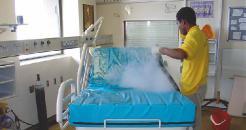
Dry steam cleaning, says Osprey DeepClean, tackles bacteria and viruses in three ways with thermal and chemical disinfec-
tion and decontamination by mechanical action of surface penetration and extraction to eliminate contaminants.
The company specialises in steam cleaning and sanitising machines. Dry steam penetrates common surfaces that are porous - like unvarnished wood - and/or have non-smooth, textured and rough surfaces that harbour and hide biofilm and soil. Dry steam vapour reaches the areas where manual cleaning isn’t possible.
Scientific studies carried out in conjunction with TNO and University College London Hospital focusing on the efficacy and removal of all biofilms and microbiological decontamination, demonstrated dry steam vapour performed equal to or better than other disinfection practices says Osprey. While the use of water and an approved detergent offers an alternative to more toxic disinfectants.
www.ospreydc.com
Time saver

The Clean ‘n Easy concept, says Wecovi, supports nurses in their daily tasks by offering quick cleaning solutions without compromising on efficacy. Comprising ready-to-use nonwoven and microfibre cloths and floor mops designed for single use these products are all ready for immediate use too. The rolled-up cloths in colour-coded dispenser buckets simplify the selection process and minimise the risk of errors.
www.wecoline.com

38 | February/March 2024 | ECJ
Europe tackles talent challenges

Europe’s got talent, and has the plaudits to prove it. But the region will need to up its game still further if it is to remain a global skills magnate at a time of fast-paced demographic change, writes Hartley Milner.
THE SWISS have found themselves the butt of more than their fair share of lampooning around national stereotypes down the years, much of it of eye-rolling banality.
In the film The Third Man, for instance, Orson Welles’ character Harry Lime says: “In Switzerland, they had brotherly love, they had 500 years of democracy and peace … and what did that produce? The cuckoo clock!” Much the same can be said of jibes decrying the Alpine state as a nation of wooden bear whittlers or yodeling goat-herders.
Switzerland has long laid such dated tropes to rest by showing the world it has a great deal to yodel about. Today, the small landlocked country punches well above its weight internationally, having one of the highest levels of per capita GDP, driven largely by the services sector. Along with a thriving economy, its citizens enjoy some of the highest standards
of healthcare and well-being, housing, education, public transport, environmental stewardship and societal security. Life expectancy is also high, around 84 years.
So it is no surprise Switzerland has become a seductive destination for expats seeking a new life and job opportunities. In fact, it ended 2023 as the best country for attracting and nurturing skilled workers in the Global Talent Competitiveness Index (GTCI) for the 10th successive year.
High earning potential
Key to the country’s consistent charttopping success is the high earning potential it offers, coupled to one of the lowest tax rates. The average salary for a single person is €81,818 a year. Zero income tax is paid on the first €13,600 to a maximum of 13.20 per cent on earnings of €166,200 and above. While living costs are notoriously high, inflation remains among the lowest in the world, at 1.70 per cent in December.
European countries dominated the talent table, taking 17 of the top 25 places behind Switzerland, Singapore and the United States. Also prominent in the rankings were Denmark, the Netherlands, Finland, Norway, Sweden, the United Kingdom, Luxembourg and Ireland.
Germany, Iceland, Belgium, Austria, France, Estonia, Malta and the Czech Republic also made the cut.
Looking back at the past decade, the GTCI report highlights that the top positions have remained remarkably stable over the years. Eight of the highest placed countries in the top 10 in 2023 were also among the top 10 in 2013 when French not-for-profit business school INSEAD first started publishing the index.
Titled ‘What a Difference Ten Years Make and What to Expect for the Next Decade’, the report flags that all these nations have built reputations as attractive places to build careers and raise families. In this, it says they are showing the way for other countries to sustainably boost their economies during a period of worldwide skills shortages.
However, Europe’s continuing dominance of the standings is far from assured, according to Doris SohmenPao, chief executive officer of the Human Capital Leadership Institute and knowledge partner of the GTCI. She said: “While there has been minimal movement in the rankings over the past 10 years, there have been rapid changes in talent
BUSINESS: TALENT February/March 2024 | ECJ | 39 Continued page 40
Europe tackles talent challenges (continued)
management across industries. This is especially so within companies as they respond to technological transformations and the Covid pandemic, as well as the drive for sustainability. We imagine the next decade will see more visible changes in the rankings with countries in Asia advancing in competitiveness, mirroring growth across their industries.”
Cracks are already beginning to appear in the status quo. Emerging economies among the 134 countries that comprise the GTCI are showing themselves to be especially tenacious. The United Arab Emirates (UAE), South Korea and Israel have all joined the top 25, while China and Russia climbed to 40th and 52nd place respectively. Indonesia leads developing states as the most prolific climber over the past 10 years while Mexico and Brazil are also advancing strongly. At the same time, some European countries slipped in the rankings, including the UK, Luxembourg and Iceland.
But why the disruption now after such a long period of stability? “Changes are brewing beneath the surface,” explained Felipe Monteiro, INSEAD senior affiliate professor of strategy and co-author of the report. “If we take the combined GDP of the E7, meaning the seven top emerging economies, they are comparable to the G7. Actually, if we take in the PPP (purchasing power parity) terms, they could be even higher.”
World of work transformation
Stressing the advances made by China, Indonesia, Mexico and Brazil, Monteiro added: “All four countries have improved in their ability to retain talent. Since 2020, the share of countries from Latin America, western Asia and the Middle East which have become talent champions has also increased.”
The GTCI authors set out how they see the next 10 years unfolding:
• Talent will gain even more importance as an element of competitiveness, innovation and geopolitical soft power for nations, cities and organisations.
• As uncertainties and international tensions continue to proliferate – in trade, investment, politics and diplomacy – so will ‘talent wars’.
• The world of work will further transform, driven by evolving expectations
L’Europe ne manque pas de talents et n’a pas besoin de le prouver. Mais cet atout doit être amplifié pour permettre au continent de rester un leader en matière de compétences à notre époque de changement démographique rapide, écrit Hartley Milner.
from younger generations, new economic models and emerging technologies like artificial intelligence (AI).
• Cities and regions will pioneer new talent strategies and innovation. Quality of life and sustainability will be critical for those aiming to become talent hubs.
• Global talent-focused policies will be crucial to prevent tensions and harness human and technological potential for a better, more sustainable and equal world.
• Skills and education will remain vital tools to empower workers to make meaningful contributions to their economies and societies.
The report cites a number of trends over the decade. One of the most recurrent themes shows the global talent competitiveness landscape is “fraught with inequalities”. Poorer countries do not perform as well as richer economies in attracting skills, and despite progress in reducing gender gaps women continue to be held back in terms of pay and career growth. The post-Covid recovery may deepen these disparities further, it suggests.
AI and new work practices that emerged following the pandemic are also changing the jobs landscape, affecting both unskilled and highly skilled workers. In the new world of work, quality of life is becoming increasingly important. This is especially so for younger, higher educated jobseekers who may pass over high-demand skilled positions for more meaningful employment where they can contribute to society or which offer a healthier work-life balance. Gig work (temporary employment) and short-term contracts are also becoming the new norm for a growing number of people.
The European Union as an economic alliance is no less exposed to such impacts. Labour force shortages persist across business sectors and skill levels, starving employers of the workers they need, especially small and medium-sized enterprises. Unemployment across the region was at a record low of six per cent in October 2023, and during the previous year job vacancies rose to 2.9 per cent … more than double the level in 2012.
Demographic shifts will only exacerbate the situation. The EU’s working age population is expected to decline from
Europa hat Talent und erntet zum Beweis den Beifall. Aber die Region muss ihre Bemühungen noch weiter verstärken, wenn sie in einer Zeit des rasanten demografischen Wandels ein globaler Kompetenzmagnet bleiben soll, schreibt Hartley Milner.
265 million in 2022 to 258 million in 2030, due in part to a tumbling birth rate and people leaving the jobs market. Europeans are living longer and healthier lives than ever before. In coming decades, the share and number of older people will increase radically, posing challenges for the staffing and financing of civic amenities such as pension systems, health and social care sectors.
Skills at a premium
“With skills at a premium worldwide, the EU’s future competitiveness will be determined by our capacity to staff our industries,” said Margaritis Schinas, vice-president for the promotion of the European way of life at the European Commission. “Our drive to fill labour market gaps has to start at home, with robust measures to support the domestic workforce. But labour migration can be an important complementary means of filling persistent gaps.”
To stay up in the global skills league, the European Commission is proposing a ‘talent mobility package’ comprising three actions:
• Making recruitment from outside the EU easier.
• Faster recognition of professional qualifications and skills gained in third countries.
• Fostering learning mobility, providing opportunities for students of all ages to develop valuable skills by going abroad to study or undertake training.
The Commission has further plans to create a talent pool of skilled jobseekers from beyond its borders. The aim will be to more quickly match skilled third country nationals with employers while helping both negotiate EU recruitment processes, living and working conditions. It is hoped the measure will also give imported workers greater protection from exploitation. Plus talent partnerships will be struck up with key donor countries to promote mobility for work or training, so increasing opportunities for legal migration while making unregulated passage less appealing.
“The new EU talent pool will be a gamechanger … the first EU-wide platform matching employers in the EU directly with jobseekers of all skills levels, all around the world,” Schinas added.
L’Europa ha talento, e ha gli elogi per dimostrarlo. Ma la regione dovrà rialzare ulteriormente il suo gioco se vuole rimanere un magnate in competenze globali in un’epoca di rapidi cambiamenti demografici, così riferisce Hartley Milner.
40 | February/March 2024 | ECJ
BUSINESS: TALENT

THE COMMERCIAL CLEANING industry is currently experiencing a phase of intense change. Driven by growing ecological and economic requirements as well as technological progress, companies are faced with the challenge of meeting new standards. In this dynamic phase, flexibility and adaptability are becoming key components for success - for manufacturers and service providers alike.
Sustainability, personnel development and digitalisation are topics that are currently relevant, but also point the way to the future of the industry.
How resources can be used more efficiently is one of the key issues in a sustainable world. Cleaning companies must find ways to make their services more environmentally friendly and provide evidence of this - while maintaining a consistently high level of cleaning quality. The selection of highly efficient cleaning machines, whose performance is optimally matched to the area of application and which use environmentally friendly cleaning agents to save energy and water, is just as important as the implementation of sustainable business models.
The shortage of skilled workers is also becoming increasingly important. Attracting and retaining qualified staff has long since become a strategic challenge for cleaning service providers. Attractive working conditions, investment in training programmes and further training measures as well as the use of modern technologies and methods are decisive factors in the competition for talented employees.
Digitalisation, artificial intelligence and the Internet of Things are both a challenge and an opportunity. This is because they open up new possibilities for making cleaning processes more efficient and sustainable. Buildings are also becoming increasingly intelligent - the concept of smart buildings is playing an increasingly important role. The integration of intelligent systems, the networking of machines and the data-driven optimisation of processes are just some of the ways in
Equipped for the future
which digitalisation is revolutionising the cleaning industry.
However, growing cost pressure and the unstable economic climate are also forcing companies to find innovative solutions to reduce water, chemical and energy consumption, work more efficiently and maintain the quality of their services at the same time.
A clean environment
Sustainability is now a fundamental prerequisite for long-term competitiveness and market acceptance - and is becoming a key challenge. The industry is responding: by turning to much more sustainable practices.
A key aspect of this is the reduction of resource consumption. By developing and promoting innovative technologies, cleaning processes can be made significantly more efficient. Modern cleaning systems use advanced techniques that minimise the need for aggressive chemicals without affecting the cleaning result. They ensure that only as much cleaning chemical is used as is actually needed - and with drip accuracy. This protects the environment and people’s health. In line with this is the increasing focus on biodegradable cleaning agents that achieve an effective cleaning performance without harmful residues.
The development of even more energyefficient machines is also a step in the right direction. As they consume less energy, they are more environmentally friendly to use and therefore offer potential for long-term cost savings.
Promoting the circular economy is an essential part of manufacturing sustainable machines. Refurbishing allows machines to go through further life cycles. Recycled material reduces the impact on the environment. The high machine quality is maintained.
Overall, these trends reflect the industry’s growing awareness of its ecological responsibility and show ways in which commercial cleaning can be made even more environmentally friendly
The commercial cleaning industry is currently experiencing a phase of intense change. Driven by growing ecological and economic requirements as well as technological progress, companies are faced with the challenge of meeting new standards. Heading up this special report on scrubber dryers is Sabine Paul from manufacturer Hako, who tells us about the key factors influencing the development of new machines –including sustainability, labour force challenges, digitalisation, cost pressure, service and user preferences.
in the future.
Focus on user needs
When selecting cleaning machines, the needs and requirements of the user are also becoming increasingly important.
User-friendliness is the top priority here. Cleaning machines should not only be powerful, but also easy and intuitive to operate. This saves valuable time when training new employees, reduces costly operating errors and increases productivity during use - also because the user can perform the required cleaning tasks quickly and flexibly with a machine that is optimally adapted to the area of application.
The ease of use of the machines is just as important. Ergonomically optimised, with user-friendly controls and intuitive handling, they make a significant contribution to occupational safety and increase the efficiency of cleaning processes. Low effort, high seating comfort and optimum
SCRUBBER DRYERS
February/March 2024 | ECJ | 41 Continued page 42
SCRUBBER DRYERS
Equipped for the future (continued from page 41)

adaptation to the individual physical needs of the user are further details that enable back-friendly and fatigue-free work during sometimes long cleaning operations.
Cost efficiency also remains a key issue: machines should not only be profitable to purchase, but also save costs during operation. Aspects such as energy efficiency, durability of materials and low maintenance costs are key. These factors are crucial for a sustainable, cost-efficient clean-
ing solution. Just like innovations that lead to shorter set-up and maintenance times. For example, automatic filling systems, fast-charging batteries and technologies that minimise the consumption of water and cleaning agents can make a significant contribution to increasing efficiency. Such advances are essential to meet the needs of users and steer the industry towards a greener future.
The technological revolution
Technological developments in commercial cleaning are making huge strides - driven by digitalisation. A key element is the increasing integration of robotics into the cleaning process. Autonomous machines equipped with advanced sensors and navigation algorithms can clean rooms independently. This reduces the manual workload, enables continuous, efficient cleaning and achieves very good results thanks to consistently high cleaning quality.
Another key advance is the combination of cleaning technology with artificial intelligence (AI). Machines equipped with AI can adapt to different environments and specific cleaning requirements, enabling a more precise and effective cleaning performance. In particular, the concept of predictive maintenance - the ability of machines to recognise and communicate their own maintenance needs. This approach reduces operating costs while increasing the availability and longevity of the machines.
In addition, intelligent fleet management systems enable optimised coordination and monitoring of cleaning machines. These systems provide

42 | February/March 2024 | ECJ
real-time data on the operating status, operating times and performance of each machine, resulting in optimal scheduling and resource utilisation.
Overall, digitalisation and artificial intelligence in building cleaning not only lead to an increase in efficiency and productivity, but also to a higher quality of cleaning services.
Improving customer satisfaction with excellent service
The economic situation remains tense. Investments are being held back, company profits are shrinking and cost-cutting measures are the order of the day. In order to optimise the costs of commercial cleaning, companies must adapt their products and services even better to the needs and budgets of their customers.
In view of the economic challenges, it is
En tête de ce rapport spécial sur les autolaveuses, Sabine Paul, de la société Hako, nous parle des facteurs clés qui influencent le développement de nouvelles machines, en particulier la durabilité, la collaboration des opérateurs, la numérisation, la pression des coûts, le service, et les préférences de l’utilisateur.
also crucial to offer attractive procurement alternatives. Rental and leasing options are becoming increasingly attractive, as they can be flexibly adapted to the customer’s requirements.
The provision of short-term procurement alternatives is also becoming increasingly important. They enable cleaning service providers to quickly and easily adapt their machine usage to changing cleaning requirements - for example, through short-term rental contracts and modular service packages that enable rapid scaling and adaptation to different cleaning tasks.
Successfully shaping change: a look into the future
The commercial cleaning industry is constantly on the move. The direction it is taking due to changing conditions and
Der Sonderbericht über Scheuersaugmaschinen entstand unter Leitung von Sabine Paul (Hako), die uns über die wichtigsten Faktoren bei der Entwicklung neuer Maschinen informiert – darunter Nachhaltigkeit, Herausforderungen der Arbeitskräfte, Digitalisierung, Kostendruck, Service und Benutzerpräferenzen.
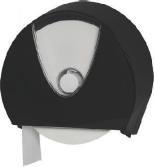

SCRUBBER DRYERS
technological developments is exciting - and challenging at the same time. But challenges become opportunities when they lead to improved utilisation as an impetus for innovation.
Companies that adapt to the changing market and changing requirements, integrate innovative and sustainable technologies and offer customer-oriented services will be able to strengthen or even further expand their market position. And master the balancing act between ecological success and economic responsibility by protecting the environment, remaining technologically up-to-date and financially profitable.
The next edition of ECJ will have a comprehensive preview of Interclean Amsterdam
Paul
servizio speciale sulle lavasciuga pavimenti e ci parla dei fattori fondamenti che influenzano lo sviluppo di nuove macchine, fra queste sostenibilità, problematiche della manodopera, digitalizzazione, pressione dei costi, servizio e preferenze degli utenti.





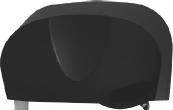
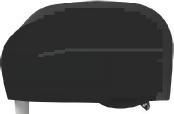

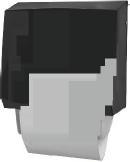


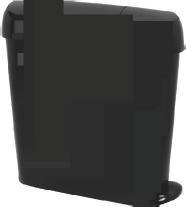

 Sabine
della Hako dirige questo
Sabine
della Hako dirige questo
February/March 2024 | ECJ | 43
PRODUCTS: SCRUBBER DRYERS
• La dernière autolaveuse NX1K de Numatic comprend la technologie au phosphate de lithium pour des durées de marche accrues, de recharges plus flexibles, et des longévités de batterie augmentées.
• L’ULTIMAXX, autolaveuse produite par Taski, offre 10 000 permutations, une conception durable et une technologie intelligente.
• Truvox met en avant l’aptitude de sa gamme d’autolaveuses Multiwash PRO à attaquer toutes les surfaces - moquettes, parquets, escalators et paillassonnages.
• Hako vient de lancer le Delta Cleaning Sysem, une machine biorbitale compacte pour le nettoyage de planchers confinés.
• Gmatic Scrubbers propose une gamme d’autolaveuses accompagnées et autoportées à batterie.
• Les autolaveuses autoportées RA805 et RA905 de Cleanfix se signalent par leur maniabilité, vitesse et stabilité.
• NX1K, die neueste Produktfamilie mit Scheuersaugmaschinen von Numatic, verfügt über LithiumPhosphat-Technologie für längere Laufzeit, flexibles Laden und längere Akkulebensdauer.
• Die Scheuersaugmaschine Taski ULTIMAXX verfügt über 10.000 Permutationen, ein robustes Design und intelligente Technologie.
• Laut Truvox können die Scheuersaugmaschinen der Produktreihe Multiwash PRO auf allen Bodenoberflächen zur Reinigung eingesetzt werden –Teppiche, Hartböden, Rolltreppen und Eingangsmatten.
• Neu von Hako ist das DeltaCleaning-System, eine kompakte Doppelorbital-Maschine zur Reinigung von Böden in kleinen Bereichen.
• Im Sortiment der Scheuermaschinen von Gmatic befinden sich handgeführte und Aufsitz-Scheuersaugmaschinen.
• Die Aufsitz-Scheuersaugmaschinen RA805 und RA905 von Cleanfix zeichnen sich durch Manövrierbarkeit, Geschwindigkeit und Stabilität aus.
• La linea più nuova di lavasciuga pavimenti NX1K della Numatic sono dotate di tecnologia al litio fosfato per maggiore durata di lavoro, ricarica flessibile e maggiore durata della batteria.
• La lavasciuga pavimenti ULTIMAXX della Taski vanta 10.000 combinazioni, design duraturo e tecnologia smart.
• La Truvox afferma che la sua gamma di lavasciuga pavimenti Multiwash PRO è in grado di pulire su tutte le superfici di pavimenti, moquette, pavimenti duri, scale mobili e zerbini d’ingresso.
• La novità della Hako è il sistema Delta Cleaning System, una macchina compatta a doppia orbita per pulire i pavimenti nelle aree di piccole dimensioni.
• La Gmatic Scrubbers propone una gamma di lavasciuga pavimenti con operatore a terra e con operatore a bordo alimentate a batteria.
• Le lavasciuga pavimenti con operatore a bordo RA805 e RA905 prodotte dalla Cleanfix vantano manovrabilità, velocità e stabilità.
Next generation
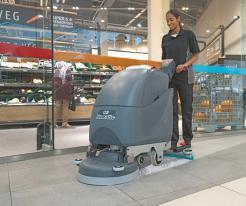
Numatic’s NX1K scrubber dryer range incorporates lithium phosphate technology, boasting longer runtime, flexible charging and extended battery life.
The company says investing in lithium compared to replacing lead batteries and the associated service costs saves money. Runtime also increases by up to 44 per cent. And NX1K Fast Charge Technology allows completely flexible charging, providing advantages in machine availability.
NX1K delivers over 4,000 charge cycles and there’s a battery warranty of up to eight years.
numatic.com
Antibacterial
ULTIMAXX scrubber dryers from TASKI featuring IntelliBac technology offer 99 per cent antibacterial and antimicrobial protection.
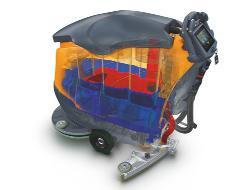
Using the antimicrobial properties of silver, IntelliBac is an active ingredient integrated into the moulded plastic of the machine. It is effective for the entire life of the tank.
taski.com
All floors
The Multiwash PRO range of scrubber dryers, says Truvox International, can be used on all floors - from carpets to hard floors, and escalators to entrance matting. Available in 24,
34 and 44 cm cleaning widths this machine washes, scrubs and dries in a single pass. Counter-rotating cylindrical brushes provide a deep clean and the easy-to-access and removable tanks allow for fast filling, emptying and cleaning. Standard tank size is four litres, an optional seven-litre tank is also available.
www.truvox.com

Into corners
Thanks to Hako’s Delta Cleaning System - the delta-shaped, double-orbital working tool - along with optimum manoeuvrability and compact design, the new Scrubmaster B5 can be used for machine cleaning close to walls and in every corner.
The ultra-flat working tool allows cleaning under shelves and furniture with a clearance of as little as 120 mm. The agile operating handle ensures maximum flexibility in all directions - it’s height-adjustable while the integrated relief spring and ball joint enable easy working. The Hako Delta Cleaning System keeps the machine neutral, without propulsion. Only the operator determines the working speed.
The lithium-ion battery powered machine weighs around 25 kg so is easy to transport from one site to another. The solution and recovery tank can be removed easily and then filled, emptied and cleaned at almost any washbasin thanks to the large tank openings. And it is safe at all times thanks to the lockable operating handle and parking stand.
www.hako.com
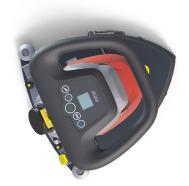
Many variants
Walk-behind scrubber dryers from Dr Gansow Gmatic come in four variants with battery capacities between two and five hours. Brush heads are 50 cm, 57 cm, 60 cm, 67 cm, 73 cm and 85 cm wide.
Rotan ride-on units, meanwhile, come in three sizes (110 litres, 155 litres and 245 litres) with batteries offering between four and six hours of use.
www.gmatic.eu

Swivelling brush
The RA805 and RA905 ride-on scrubber dryers, says Cleanfix, combine manoeuvrability, speed and stability. Featuring a swivelling brush head for cleaning close to edges and bumper protection, the wheel angle of almost 90° makes for a small turning circle.
The narrow design means both models can be easily manoeuvred through doors. Working width for the RA805 is 76 cm and 86 cm for the RA905.
Rear-wheel drive along with a powerful motor makes for optimum performance on slopes of up to 15 per cent, says Cleanfix, even with a full tank.

Brush functions, suction functions, water quantity and, in the CADS version, detergent quantity can be set on the display of the control unit. Operating hours can be read plus ECO or SPOT mode can be activated or deactivated. The display can also be switched to manual water extraction - that requires the optional suction set.
www.cleanfix.com
44 | February/March 2024 | ECJ
PRODUCTS: SCRUBBER DRYERS
3D LiDAR
The R3 ScrubPro features an ergonomic design to integrate both sweeping and scrubbing functions. This robotic machine from LionsBot is equipped with 3D LiDAR technology - enabling it to map, navigate and clean tight, intricate and vast spaces with precision and speed.

Thanks to the MagicTag there is no need for repetitive set-up, making the R3 ScrubPro accessible to users of varying skills levels with minimal training. The fleet and the operatives can be managed remotely with real-time access and comprehensive reports from the in-built LionsOS interface.
Versatile cleaning modes can suit both manual and automatic operations.
www.lionsbot.com
Redesigned
Nilfisk has redesigned it SC650 walk-behind scrubber dryer for more comfort and convenience. Operatives can get up and running faster - regardless of experience level, thanks to the user-friendly interface and intuitive controls. For ultimate convenience an accessory basket, integrated mop holder and caddy box are located within arm’s reach.
Thanks to SilentMode technology this machine can be used to clean quietly day or night,
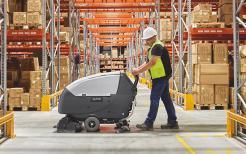

even in busy areas. There’s also optimised traction control and a new paddle box.
Compact design allows the operator to change direction in a 200 cm wide aisle for optimum manoeuvrability. And the SC650 is also designed to optimise water, energy and detergent usage. www.nilfisk.com
Less impact
Lindhaus says it developed its LW 44 Flexy and LW52 Flexy scrubber dryers to minimise environmental impact, increase productivity and reduce energy and water consumption. It says the three speeds on each motor, three water flow settings, eco function and UV-C led lights set this model apart.
The battery-powered machines can run for 90 minutes and boast fast charging, and the filtration system contains one washable Hepa filter.
www.lindhaus.it
• L’autolaveuse R3 ScrubPro de LionsBot est dotée de la technologie 3D LiDAR lui permettant de cartographier, naviguer et nettoyer avec précision.
• L’autolaveuse accompagnée SC650 proposée par Nilfisk se signale par une interface conviviale et des commandes intuitives.
• Les LW44 Flexy et LW52 Flexy sont deux nouvelles autolaveuses développées par Lindhaus pour minimiser l’impact environnemental.
• Die R3 ScrubPro von LionsBot verfügt über 3D LiDAR-Technologie, die präzises Zuordnen, Navigieren und Reinigen ermöglicht.
• Die handgeführte Scheuersaugmaschine SC650 von Nilfisk verfügt über eine benutzerfreundliche Oberfläche und intuitive Bedienelemente.
• Bei LW44 Flexy und LW52 Flexy handelt es sich um die beiden neuen Scheuersaugmaschinen, die von Lindhaus zur Minimierung der Umweltbelastung entwickelt wurden.
• La macchina R3 ScrubPro della LionsBot incorpora la tecnologia 3D LiDAR che per mette di mappare, navigare e pulire con precisione.
• La lavasciuga pavimenti con operatore al seguito SC650 della Nilfisk vanta una interfaccia di facile utilizzo e dei controlli intuitivi.
• LW44 Flexy e LW52 Flexy sono le due nuove lavasciuga pavimenti sviluppate dalla Lindhaus per minimizzare l’impatto ambientale.









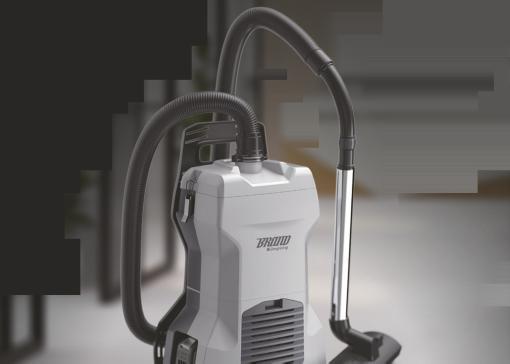



February/March 2024 | ECJ | 45
WASHROOM HYGIENE

Avoiding the queues
With Interclean Amsterdam just around the corner and the Paris Olympics due to take place this summer, what are the challenges involved when equipping the large, busy washrooms of an exhibition hall or stadium? ECJ poses the question.
THE BIGGER THE WASHROOM, the greater the cleaning and maintenance task. And the busier the washroom, the harder it is to stay on top of product run-outs and cleaning crises. This is a general rule of thumb in conference halls and sports stadiums where traffic peaks are hard to predict and where queues are liable to form at any moment.
So how can these facilities be configured and equipped to ensure they operate efficiently and seamlessly at all times?
Large, busy washrooms pose multiple service challenges according to Essity’s communications director Jenny Turner. “It can be difficult to manage the variable traffic and ensure the dispensers are kept well stocked at all times – while not replacing the products too soon,” she said. “The refill status of the dispensers needs to be tracked and the washrooms should be kept clean even when busy in order to ensure that venues such as the RAI in Amsterdam - home to the Interclean Amsterdam show - remain welcoming places to visit.”
Cleaners might struggle to keep up to speed with dispenser status when the washrooms are particularly crowded, Turner adds. “Staff members must be able to enter the washroom and refill the dispensers swiftly during these periods.”
Empty dispensers could result in a negative experience for visitors. “They could also lead to complaints – and these will spread quickly via social media.
“FMs don’t like receiving complaints because it reflects on their work, while visitors will gain a poor impression of a
venue where the washrooms are not kept well equipped,” Turner points out. “And if one washroom runs out of paper, people will use the others instead and this could lead to queues.”
She believes digital systems providing information on dispenser status and traffic levels can ease the cleaner’s burden. Essity’s Tork Vision Cleaning uses peoplecounters and connected dispensers to provide data on cleaning requirements via a smartphone, tablet or computer.
All washroom dispensers must be strategically placed to improve traffic flow, says Turner. “Paper towels speed up traffic compared with air dryers because they can be dispensed very quickly,” she adds.
The washroom experience is crucial in any high footfall environment, says Kimberly-Clark’s integrated marketing manager Nicola Jones. “Large numbers of visitors will be able to use a well-maintained, easy-to-use washroom swiftly and then quickly return to where they want to be – in the bar, the retail counter or at the event itself,” she said.
“And that’s good news for venue operators because the longer people spend in washroom queues, the less time they will have in the paid-for facilities.”
Visitors who have a poor washroom experience are less likely to linger or return in the future, she adds. “A washroom can have a major impact on a person’s enjoyment of an event, while word-of-mouth reports could quickly damage a venue’s reputation and hinder repeat visits.”
Many people
Washroom systems in a busy venue need to be able to accommodate large numbers of people at once, according to Jones. “Paper hand towels allow for fast and effective drying because users can quickly take out a towel and dry their hands as they move on,” she said. “And automatic touchless dispenser systems allow visitors to flow through a washroom more swiftly.”
Visitors to an exhibition or stadium are likely to be unfamiliar with the washroom
layout, she says. “Dispensers therefore need to be easy to use, suitable for everyone and offer clear visual cues.”
Washrooms in larger venues must also be designed to ensure a smooth flow and accommodate heavy traffic in a short space of time. “Any queues that develop could spill outside and create safety issues and congestion,” adds Jones.
Robust and reliable
“Queues can also form if there are insufficient cubicles or hand-washing stations. And the placement of hand drying facilities away from the sink will help with the movement of visitors through the washroom.”
New from Kimberly-Clark is the Icon range of touchless hand towel, soap and toilet paper dispensers which are described as being intuitive and jam-free.
Washroom systems for stadiums and exhibition halls must be durable, robust and reliable to withstand high footfall according to Hylab product manager Joshua Edwardes. “The dispenser arrangement in each washroom also needs to be customised to suit the volume of visitors and their likely usage habits,” he said.
“All dispensers should be ergonomic, intuitive, easy to use and quick to operate to keep queues to a minimum and provide a seamless and convenient user experience. And the positioning of the dispenser has an impact too - for example, paper dispensers should be placed away from sinks to allow ample space for people to use them while others are washing their hands.”
Multiple waste bins can help to reduce the need for continuous cleaning in busy washrooms where hygiene issues are likely to occur, Edwardes said. “These can be wall-mounted and slimline in design to save space in high-traffic areas.”
“Dispensers with transparent windows will allow for the easy monitoring of consumable levels and ensure efficient maintenance, while front covers that are moulded around the window will eliminate dirt traps and enhance cleanliness.”
46 | February/March 2024 | ECJ
The size, style and shape of dispensers and pumps can help to facilitate the constant supply of soap and paper, he says. “Soap dispensers with a touch-free mechanism not only reduce the risk of cross-contamination - they are also quick and hassle-free to operate,” he said.
Features such as toilet roll dispensers with a sliding mechanism will ensure that a second roll is accessible after the first one is depleted, says Edwardes. “And dispensers that can hold both a jumbo roll and a stub roll will save time and money since the dispenser will need to be refilled less often.”
Hylab’s Myriad range of dispensers are available in touch-free options and can accommodate interleaved toilet tissue, jumbo rolls and interleaved hand towels.
Keeping dispensers well stocked at all times is critical in a busy washroom, says GOJO’s managing director Chris Wakefield. “If a soap or sanitiser dispenser is allowed to run out, users will not have the opportunity to clean their hands which will increase the risk of germs being transferred around the building,” he said.
Touch-free technology ensures a steady flow throughout the washroom, he adds. “This will help to prevent congestion or queues,” said Wakefield. “Additionally, all units should be durable, easy to clean and quick to refill, while dispensers with windows will enable operatives to easily check stock levels and replenish them accordingly.”
GOJO’s Purell ES8 dispenser has an integrated battery for touch-free dispensing and a refill design that enables operatives to monitor product levels at a glance.
Foul odours
High footfall and continuous usage are the main challenges facing any large, busy washroom according to Vectair System’s vice president of marketing Chelsey Schwartz. “Frequent cleaning will be required to provide high levels of hygienebut It can be hard to ensure there are sufficient facilities to accommodate everyone during peak times,” she said.
Where there are large crowds using a washroom the fixtures and equipment can sometimes become misused or damaged – whether this is intentional or accidental,
Alors que l’Interclean Amsterdam est sur le point d’ouvris ses portes et que les Jeux Olymiques d’été se profilent à l’horizon, ECJ interroge des fournisseurs de biens et services pour toilettes publiques sur les principaux problèmes qu’ils rencontrent dans l’équipement des installations de grande taille et très fréquentées de salles d’exposition et de stades. Ils nous expliquent les stratégiques qu’ils adoptent pour en assurer la marche efficace et régulière.
she adds. “High footfall can also lead to long queues and wait times which can frustrate customers and cause them to miss part of an event,” she said. “And the rapid depletion of essential supplies such as soap can make for an unpleasant experience. Meanwhile, maintenance issues from frequent use can result in wear and tear and lead to systems malfunctioning or failing to work altogether.”
Hygiene issues that may arise from increased usage include unclean surfaces, foul odours and unsanitary conditions, Schwartz says. “Addressing these issues requires proactive management, frequent washroom inspections and adequate staffing levels, while innovative product solutions can go a long way to improve busy washroom environments.”
She says unpleasant washroom odours must be controlled and neutralised. “Poor airflow or inadequate ventilation systems can trap unpleasant odours inside the washroom rather than allowing them to dissipate. And many older buildings suffer from damp and humid conditions which can provide an ideal environment for odour-causing bacteria to thrive.”
According to Schwartz, incorporating sensors for taps, soap dispensers and hand dryers can help to enhance efficiency and hygiene. “Also, programmable dispensers work well during busier periods when footfall is high,” she said.
Feminine hygiene units must be large
and strong enough to meet high traffic demands and prevent them from overflowing, she said. “If a busy washroom is to be run successfully it requires a combination of smart design, good facilities management, the use of technological solutions and strategic planning.”
Keep stocks up
Vectair’s battery-powered Vibe Pro aircare dispenser is programmable and can be set according to a venue’s preferences. Its patented Intensity Plus Event technology provides a targeted boost of fragrance at the busiest part of the day.
So what are manufacturers’ top tips for equipping a high-traffic washroom?
“Busy venues require durable products that aren’t easily broken,” says Schwartz. “So all products should be robust, hardwearing and equipped with anti-vandalism features such as locks to prevent damage.”
Systems should be easy to operate, appropriately sized and kept well-stocked to keep queues to a minimum, according to Hylab’s Joshua Edwardes. “Jumbosized products are a good option for busy washrooms to ensure a sufficient supply, while dispensers that allow for quick and hassle-free cartridge changes will ease the replenishment process,” he said.
And Kimberly-Clark’s Nicola Jones advocates the use of touchless dispensing systems. “They allow more people to move quickly and easily through the washroom with minimal touchpoints.”

Da die Interclean Amsterdam vor der Tür steht und die Olympischen Spiele in diesem Sommer stattfinden werden, fragt das ECJ die Waschraumanbieter nach den größten Herausforderungen, die die Ausstattung der großen, geschäftigen Waschräume von Ausstellungshallen und Stadien mit sich bringen. Und wir finden heraus, welche Strategien sie einsetzen, um den effizienten und reibungslosen Betrieb dieser Einrichtungen sicherzustellen.
Con la Interclean Amsterdam alle porte e le Olimpiadi che si terranno questa estate, ECJ chiede ai fornitori di servizi quali siano le maggiori sfide che si devono affrontare quando si equipaggiano i grandi e affollati bagni dei padiglioni fieristici e degli stadi. Scopriamo inoltre che strategie adotteranno per mantenere queste strutture funzionanti e senza problemi.
WASHROOM HYGIENE February/March 2024 | ECJ | 47
PRODUCTS: WASHROOM HYGIENE
• Discrète, la poubelle Sanitaire XIBU de Hagleitner se distingue par son profil effilé et la possibilité d’un montage mural.
• Mediclinics a lancé le sèche-mains U-Flow dont le dessin en U donne une liberté de mouvement aux mains.
• Pour réduire au maximum les éclaboussures d’urinoir, Vectair Systems a mis au point l’écran d’urinoir V-Screen Dual.
• Essity prône la durabilité et la douceur de ses nouveaux papiers hygiéniques et serviettes Tork Natural Colour.
• La gamme Obsidian de distributeurs sanitaires de Kennedy Hygiene est fabriquée à partir de plastique recyclé.
• Le distributeur automatique de savonnettes Lesseau a été développé pour proposer une solution durable face à l’usage de savon liquide.
• Der Hygienebehälter XIBU von Hagleitner ist dank seines schlanken Designs diskret und kann auch an der Wand montiert werden.
• Neu von MediClinics ist der Handtrockner U-Flow mit U-förmigem Design, damit Hände Bewegungsfreiheit haben.
• Zur maximalen Spritzwasserreduzierung an Urinalen hat Vectair Systems das Urinalsieb V-Screen Dual entwickelt.
• Essity sagt, dass Toilettenpapier und Handtücher aus dem neuen Sortiment Tork Natural Colour Nachhaltigkeit mit Weichheit verbinden.
• Die Waschraumspender der Obsidian-Reihe von Kennedy Hygiene werden aus recyceltem Kunststoff hergestellt.
• Der automatische Lesseau Stückseifenspender wurde als nachhaltige Lösung für Flüssigseife entwickelt.
• Il contenitore per rifiuti sanitari XIBU Sanitary Bin della Hagleitner è discreto grazie al suo design slanciato e può anche essere montato a parete.
• Il nuovo prodotto della Mediclinics è l’asciugamani U-Flow, dotato di design a forma di U per permettere i movimenti liberi delle mani.
• Per la massima riduzione degli spruzzi degli orinatoi, la Vectair Systems ha sviluppato le griglie V-Screen Dual.
• La Essity afferma che la sua nuova carta igienica e asciugamani Tork Natural Colour abbinano sostenibilità e morbidezza.
• La gamma Obsidian di dispenser per servizi igienici di Kennedy Hygiene è realizzata in plastica riciclata.
• Il dispenser automatico di sapone solido Lesseau è stato sviluppato come alternativa sostenibile al sapone liquido.
Sanitary disposal

The XIBU Sanitary Bin from Hagleitner is a waste disposal solution for personal hygiene items - enabling them to be disposed of cleanly, discreetly and odour-neutral. Available as both a manual and hybrid version - in the hybrid option the lid opens with a simple hand movement.
The slim format - which comes in black or white - saves space and can be wall-mounted. Thanks to digital application data, the hybrid bin notifies staff when service is required - and it is easy to operate and refill. Daily emptying is not necessary, the service interval can be up to four weeks and the hygiene powder inside has a long-lasting odour neutralising effect.
www.hagleitner.com
U-shaped dryer
New from Mediclinics is the U-Flow hand dryer, featuring a U-shaped design said to allow total freedom of movement of the hands.
Other features include HEPA filter media, Biocote antibacterial additive and an ioniser to eliminate viruses and bacteria.
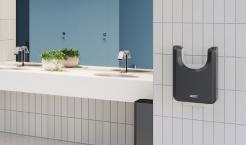
The double water tank accumulates liquid during hand drying and there is a kit for direct connection to the drain pipe. Energy consumption, says Mediclinics, is low and the plug-in kit allows U-Flow to be installed or replaced in less than a minute.
www.mediclinics.com
Reduce splash
Designed to reduce splash in washroom urinals, Vectair Systems has designed a range
of screens. The V-Screen Dual, for example, gives double-sided protection and is effective at splash reduction regardless of installation. P-Screen also provides splash-back reduction with the added benefit of an enzyme block to help keep drains clean and reduce odours.
The company designed the V-Screen Halo specifically for waterless urinals, which often suffer from bad odours. It provides a universal fit to waterless conversion cartridges with its flexible fingers that fit around most cartridges. There’s also double-sided splash-back protection and a pleasant fragrance.
www.vectairsystems.com

Paper softness
Claimed to combine sustainability with softness are new Tork Natural Colour toilet paper and hand towels from Essity. These are light brown in hue, FSC and EU Ecolabel certified and are made from 100 per cent recycled fibres. Around 30-50 per cent of the fibres used in the products originates from used corrugated containers such as shipping cartons while the remainder comes from other recycled fibre sources such as sorted office paper.
As a result, products in the range offer a high level of softness, according to Essity, while their natural colour helps to demonstrate a company’s sustainability values.
Products in the Tork Natural Colour range are Tork Matic
Natural Hand Towel Roll; Tork
Xpress Soft Natural Multifold Hand Towel Advanced; Tork
Natural Coreless Mid-Size Toilet

Roll Advanced and Tork Natural
Mini Jumbo Toilet Roll Advanced. All refills can be used with existing Tork dispenser systems.
www.tork.co.uk
Deep black
Kennedy Hygiene’s Obsidian line of washroom dispensers is made from recycled plastic and its name is derived from the gemstone known for its deep black colour.

On average 85 per cent of the plastic used is recycled ABS sourced in Europe - its production releases four times less CO2 than virgin ABS.
All models are designed to optimise consumable consumption and are packaged using 75 per cent recycled cardboard. Responsibly sourced consumables are also available.
kennedy-hygiene.com
Solid soap bar

The automatic Lesseau bar soap dispenser was developed to create a sustainable alternative to liquid soap, by using a soap bar. This, says the manufacturer, means less transport, no transport of water and no use of any plastic packaging.
The battery-operated unit scrapes fine powder from the soap bar automatically and dispenses it onto the hands. On one battery charge the device can last for between six and 14 months depending on the intensity of use. To recharge, a USB-C cable is used.
The system offers continuous refill. When the soap bar is half finished, just put a new one on top - nothing is wasted.
lesseausoap.com
48 | February/March 2024 | ECJ

Reader registration form
February/March 2024
To receive ECJ free of charge (subject to qualification), complete the form below.
Name ....................................................................
Job title ................................................................................
Company ...............................................................................
Address ................................................................................
Postal code ............................................................................
Country .................................................................................
Tel ........................................................................................
Fax ......................................................................................
E-mail ..................................................................................
Web site ................................................................................
Please sign here only if you wish to receive a regular copy of European Cleaning Journal (the publisher reserves the right to accept or refuse application).
Signature ......................................... Date...................
Please tick just one box in each section.
Your company’s main business activity:
q Factory & industrial premises
q Offices & commercial premises (including banks)
q Contract cleaning/cleaning services
q Distributors/wholesalers
q Health authorities/hospitals/ nursing homes
q Central and local government
q Hotels/catering/recreation (including leisure centres)
q Education establishments (including universities, schools & colleges)
q Other (please specify)
Number of company employees:
Are you personally responsible for purchasing or specifying machinery, materials, products, equipment or support services used in the cleaning and maintenance of non-domestic establishments? q Yes q No
q None of the above.
Scan and email your completed form to: marie@europeancleaningjournal.com. Or register online at www.europeancleaningjournal.com








































































































































































































 Sabine
della Hako dirige questo
Sabine
della Hako dirige questo






























